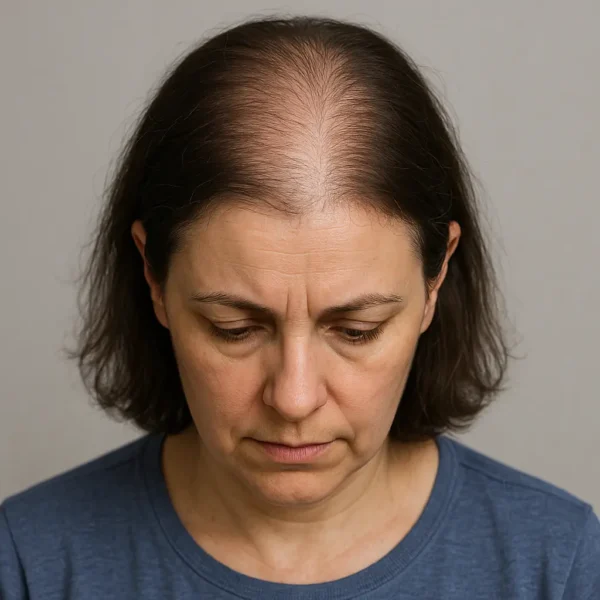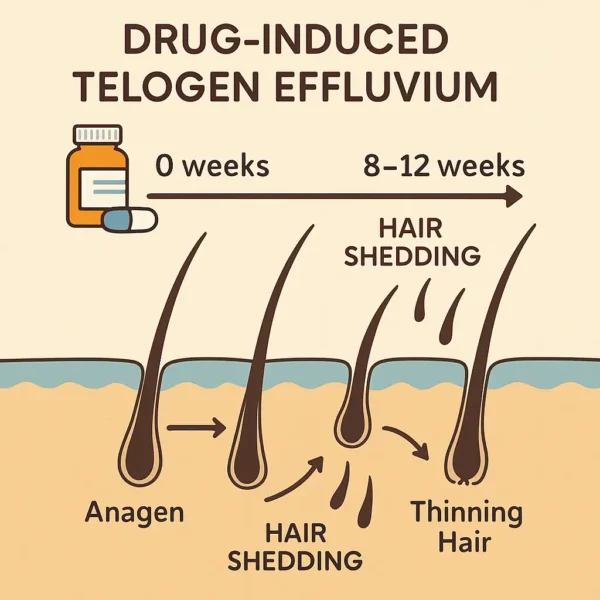Losing between fifty and a hundred hairs a day is a normal part of the scalp hair growth cycle. However, when the rate of shedding suddenly accelerates doctors use the term “effluvium” (usually a telogen effluvium). Effluvium is not a diagnosis in itself but a visible sign that an internal or external factor has pushed many follicles to abandon the growth phase at once. While most people have heard of telogen effluvium triggered by childbirth or by prescription drugs, far fewer realise that common industrial chemicals, trace elements in drinking water, plant toxins, and even some essential minerals in excess or deficiency, can set the same process in motion. This article explains how that happens what warning signs to watch for and how full recovery is usually possible once exposure stops.
What happens inside the follicle: Hair follicles cycle through hair growth, rest, and shedding. In a healthy scalp, roughly eighty five percent of follicles are actively producing fibers in the anagen, or growth, phase. A sudden toxic exposure can shock a large cohort into telogen, the resting phase. Two or three months later, those hairs loosen and fall. Because the follicle itself is not scarred, the condition is reversible. Once the trigger is removed, new anagen hair production begins, and visible regrowth follows over several months. The temporary nature of the hair loss is reassuring, but return to full scalp density can only be achieved after the source of toxicity is identified and eliminated.
It’s the dose makes the poison: Several metals that are indispensable micronutrients at low concentrations become toxic at high doses when the body burden rises. Iron supports oxygen transport, yet both iron deficiency and iron overload, whether arising from hereditary hemochromatosis or contaminated water, can precipitate telogen effluvium. Zinc is vital for DNA repair and protein synthesis, but excess intake from galvanised plumbing or over enthusiastic supplementation, paradoxically impairs those same processes in the follicle. Even selenium, required in parts per billion for antioxidant enzymes in our bodies, can replace the sulfur rich amino acid cysteine when present at a high concentration. Cystine bridges provide tensile strength to each hair strand, so their displacement weakens the fiber and signals follicles to pause production.
A similar double edged principle applies to iodine. Adequate iodine keeps the thyroid gland working smoothly. Too little or too much destabilises thyroid hormone output, which in turn derails the metabolic synchronization of the follicle and produces diffuse shedding. Balanced nutrition therefore matters just as much as avoiding overt poisoning.
Industrial chemicals at work and at home: The modern chemical economy exposes workers, and occasionally the wider community, to thousands of synthetic molecules. Chloroprene, generated during the manufacture of neoprene rubber, can linger as monomers or dimers in factory air. Chronic inhalation has been linked to a step like increase in telogen hairs among plant employees. Potassium thiocyanate, once used as an antihypertensive, can still be encountered in older laboratory stocks; animal studies show that it displaces iodine from the thyroid, prompting telogen effluvium through the endocrine route described above. Trimethadione, an anticonvulsant now rarely prescribed, induced prominent shedding when first introduced because blood levels often rose close to cytotoxic territory before therapeutic monitoring became routine.
Bismuth provides a vivid illustration of how multipurpose metals drift into consumer products. The shimmering powder that lends a pearlescent glow to some lipsticks and eye shadows is sometimes a bismuth salt. Occasional exposure is harmless, yet habitual ingestion of bismuth containing products can elevate systemic levels long before gastrointestinal symptoms appear. When that happens, the hair matrix is among the first tissues to suffer.
Metals that hide in the water supply: Lead pipes remain an unfortunate legacy in many nineteenth century European buildings. Water that stagnates overnight dissolves lead carbonate, giving residents a morning dose that accumulates in bone and soft tissue. Lead interferes with mitochondrial energy production in rapidly dividing cells, and the hair matrix keratinocytes are especially vulnerable. Aluminium sulfate, used by some municipalities as a water clarifying agent, can also leach into tap water if the dosing system fails. Although the element’s effect on the brain dominates public debate, aluminium additionally slows keratin polymerisation, producing fast onset shedding. Gold is a rare culprit, yet mining runoff or obsolete dental materials occasionally add enough gold salts to local water to trigger alopecia in susceptible individuals.
Mercury and arsenic – the classic poisons: Mercury exposure is most often dietary, arising from eating large predatory fish that concentrate methylmercury through marine food webs. A high seafood intake, combined with genetically slower excretion, can push blood mercury above the threshold that damages the hair follicle outer root sheath.
In the nineteenth century, hat makers breathed mercuric nitrate vapour, as it was used as part of the hat making process, and became “mad as a hatter” (of Alice in Wonderland fame); they also lost clumps of hair. Although industrial controls on mercury exposure have much improved, certain illicit hair bleaching pastes still occasionally appear in the grey market in Africa and Asia and some contain mercury for its quick whitening effect. Regular users commonly notice tufts of hair on the pillow within weeks. Mercury is also used to extract gold in some processes. In illegal mines where there are no safety controls, miners can sometimes be exposed to high mercury concentrations and corresponding hair loss.
Arsenic persists in pesticides, treated timber, and even some folk remedies. The metal binds to sulfur groups in keratin, creating brittle bridges that fracture as the hair fiber emerges. Because arsenic also affects nail plates, striped ridging of the fingernails, coupled with hair thinning, can provide an important diagnostic clue to arsenic poisoning.
Plant toxins that imitate heavy metals: Nature has evolved potent chemical weapons of its own. Lecythis species, known as coco de mono, contain selenocystathionine, a selenium compound that mirrors laboratory produced sodium selenite in its ability to halt hair production. Mimosine from the Leucaena plant occupies the iron pocket of several enzymes, stalling DNA synthesis in follicular bulbs. Seeds of Abrus precatorius, the rosary pea, carry abrin, a ribosome inactivating protein so powerful that one crushed seed can create dramatic anagen effluvium arrest and later telogen effluvium. Colchicine in several lily family tubers binds tubulin, blocking cell division; this explains its dual role as a gout medicine and also as an accidental cause of bald patches it it’s misused as a herbal painkiller.
Ionising radiation and cytostatic drugs: X rays, gamma rays, and beta particles all break DNA strands. During radiotherapy the beam is tightly focused on tumours, yet scalp follicles near the field edge can still receive enough stray dose to shut down temporarily. Chemotherapy agents achieve a similar systemic effect. They target rapidly dividing cancer cells, but the hair germ is among the fastest growing tissues in the body and becomes collateral damage. Hair loss under these circumstances fits the definition of chemical induced effluvium, even though the agents are intentionally delivered. Regrowth commonly starts one or two months after the last cycle.
Recognising the problem: Chemical or metal induced effluvium usually presents as diffuse thinning rather than the patterned recession seen in androgen driven hair loss. The parting appears wider, whole handfuls may come out in the shower with heavy exposure, and the scalp skin becomes visible under bright light. Because the trigger often occurred several weeks earlier, the causal link can easily be missed. A detailed timeline of new medications, dietary changes, workplace shifts, travel, and cosmetic treatments is therefore essential when tracking down the cause of a telogen effluvium. Blood tests for complete blood count, ferritin, thyroid function, and specific metals can help confirm suspicions, though a physician should interpret results carefully as reference ranges vary by laboratory.
Treatment is usually simple: Unlike scarring alopecias, effluvium does not destroy follicles. The cornerstone of therapy is removing or correcting the insult. Switching to uncontaminated water, wearing protective equipment at work, modifying drug dosage, or stopping a supplementary pill often suffices. Supportive measures include gentle hair cleansing to avoid additional traction, avoiding harsh dyes until recovery, and ensuring adequate protein intake. Topical minoxidil can shorten the resting phase and may accelerate visible return, and is used by some dermatologists. Psychological support also matters, because sudden hair loss can provoke significant anxiety even when the longer term prognosis is excellent.
Public health and prevention: Many cases of metal toxicity arise from infrastructure that predates modern safety codes. Municipal replacement of lead and galvanised pipes yields benefits for neurology, renal function, and hair health alike. Industry still requires vigilant monitoring of air and water effluent because of the potential exposure risks to health in people working and living near the factory.
On the personal level, reading the ingredient list on herbal products and cosmetics remains the first line of defence. Regulatory bodies are closing loopholes, yet niche online marketplaces sometimes bypass this oversight. Consumers should favour reputable brands that conduct purity tests on the ingredients thy use.
Healthcare providers can contribute by keeping telogen effluvium in mind whenever they encounter unexplained diffuse hair shedding. A single question about occupation or supplement use can uncover an avoidable exposure long before invasive investigations or drug prescriptions are considered.
Conclusion: Hair serves as a visible barometer of internal well-being. When hundreds of hair strands shed without warning, it signals that metabolic harmony has been disturbed. Chemicals and metals, whether essential nutrients in excess, industrial pollutants, or plant derived toxins, have a unique capacity to tip follicles into premature telogen. Understanding that the process is usually reversible once the culprit is identified offers comfort and a clear path to recovery. It also reminds us that the boundary between benefit and harm is delicate, and that mindful stewardship of our chemical environment protects not only vital organs but also the everyday confidence we draw from a healthy head of hair.
Bibliography
11711645 {11711645:UU82L4J2},{11711645:N3XFNQ36},{11711645:SHUIK35X},{11711645:NV2LM7VD},{11711645:ZJSZHT5Q},{11711645:NUR5DN26},{11711645:LEA3V6MY},{11711645:6LLY278F},{11711645:N89HSIVP},{11711645:SIVIR5A2},{11711645:KVEEZ3R2},{11711645:3QSLNQJW},{11711645:AHIIU5D3},{11711645:BUZKH8CW},{11711645:V3XER82C},{11711645:4N4S97TB},{11711645:CNCSB7JX},{11711645:C8ME9PQ6},{11711645:FEG52Y85},{11711645:5HIWR34Z},{11711645:SPRPQRBQ},{11711645:A5HFJSS7},{11711645:G2P8VEFX} 1 vancouver 50 date asc 1917 https://www.keratin.com/wp-content/plugins/zotpress/ %7B%22status%22%3A%22success%22%2C%22updateneeded%22%3Afalse%2C%22instance%22%3Afalse%2C%22meta%22%3A%7B%22request_last%22%3A0%2C%22request_next%22%3A0%2C%22used_cache%22%3Atrue%7D%2C%22data%22%3A%5B%7B%22key%22%3A%22V3XER82C%22%2C%22library%22%3A%7B%22id%22%3A11711645%7D%2C%22meta%22%3A%7B%22creatorSummary%22%3A%22Chapman%20and%20Main%22%2C%22parsedDate%22%3A%221967-02%22%2C%22numChildren%22%3A0%7D%2C%22bib%22%3A%22%26lt%3Bdiv%20class%3D%26quot%3Bcsl-bib-body%26quot%3B%20style%3D%26quot%3Bline-height%3A%201.35%3B%20%26quot%3B%26gt%3B%5Cn%20%20%26lt%3Bdiv%20class%3D%26quot%3Bcsl-entry%26quot%3B%20style%3D%26quot%3Bclear%3A%20left%3B%20%26quot%3B%26gt%3B%5Cn%20%20%20%20%26lt%3Bdiv%20class%3D%26quot%3Bcsl-left-margin%26quot%3B%20style%3D%26quot%3Bfloat%3A%20left%3B%20padding-right%3A%200.5em%3B%20text-align%3A%20right%3B%20width%3A%201em%3B%26quot%3B%26gt%3B1.%26lt%3B%5C%2Fdiv%26gt%3B%26lt%3Bdiv%20class%3D%26quot%3Bcsl-right-inline%26quot%3B%20style%3D%26quot%3Bmargin%3A%200%20.4em%200%201.5em%3B%26quot%3B%26gt%3BChapman%20RS%2C%20Main%20RA.%20Diffuse%20thinning%20of%20hair%20in%20iodide-induced%20hypothyroidism.%20Br%20J%20Dermatol.%201967%20Feb%3B79%282%29%3A103%26%23x2013%3B5.%26lt%3B%5C%2Fdiv%26gt%3B%5Cn%20%20%20%26lt%3B%5C%2Fdiv%26gt%3B%5Cn%26lt%3B%5C%2Fdiv%26gt%3B%22%2C%22data%22%3A%7B%22itemType%22%3A%22journalArticle%22%2C%22title%22%3A%22Diffuse%20thinning%20of%20hair%20in%20iodide-induced%20hypothyroidism%22%2C%22creators%22%3A%5B%7B%22creatorType%22%3A%22author%22%2C%22firstName%22%3A%22R.%20S.%22%2C%22lastName%22%3A%22Chapman%22%7D%2C%7B%22creatorType%22%3A%22author%22%2C%22firstName%22%3A%22R.%20A.%22%2C%22lastName%22%3A%22Main%22%7D%5D%2C%22abstractNote%22%3A%22%22%2C%22date%22%3A%221967-02%22%2C%22section%22%3A%22%22%2C%22partNumber%22%3A%22%22%2C%22partTitle%22%3A%22%22%2C%22DOI%22%3A%2210.1111%5C%2Fj.1365-2133.1967.tb11464.x%22%2C%22citationKey%22%3A%22%22%2C%22url%22%3A%22%22%2C%22PMID%22%3A%22%22%2C%22PMCID%22%3A%22%22%2C%22ISSN%22%3A%220007-0963%22%2C%22language%22%3A%22eng%22%2C%22collections%22%3A%5B%22FBHCGH8X%22%5D%2C%22dateModified%22%3A%222025-08-07T14%3A14%3A45Z%22%7D%7D%2C%7B%22key%22%3A%22G2P8VEFX%22%2C%22library%22%3A%7B%22id%22%3A11711645%7D%2C%22meta%22%3A%7B%22creatorSummary%22%3A%22Stein%20et%20al.%22%2C%22parsedDate%22%3A%221973-07%22%2C%22numChildren%22%3A0%7D%2C%22bib%22%3A%22%26lt%3Bdiv%20class%3D%26quot%3Bcsl-bib-body%26quot%3B%20style%3D%26quot%3Bline-height%3A%201.35%3B%20%26quot%3B%26gt%3B%5Cn%20%20%26lt%3Bdiv%20class%3D%26quot%3Bcsl-entry%26quot%3B%20style%3D%26quot%3Bclear%3A%20left%3B%20%26quot%3B%26gt%3B%5Cn%20%20%20%20%26lt%3Bdiv%20class%3D%26quot%3Bcsl-left-margin%26quot%3B%20style%3D%26quot%3Bfloat%3A%20left%3B%20padding-right%3A%200.5em%3B%20text-align%3A%20right%3B%20width%3A%201em%3B%26quot%3B%26gt%3B1.%26lt%3B%5C%2Fdiv%26gt%3B%26lt%3Bdiv%20class%3D%26quot%3Bcsl-right-inline%26quot%3B%20style%3D%26quot%3Bmargin%3A%200%20.4em%200%201.5em%3B%26quot%3B%26gt%3BStein%20KM%2C%20Odom%20RB%2C%20Justice%20GR%2C%20Martin%20GC.%20Toxic%20alopecia%20from%20ingestion%20of%20boric%20acid.%20Arch%20Dermatol.%201973%20July%3B108%281%29%3A95%26%23x2013%3B7.%26lt%3B%5C%2Fdiv%26gt%3B%5Cn%20%20%20%26lt%3B%5C%2Fdiv%26gt%3B%5Cn%26lt%3B%5C%2Fdiv%26gt%3B%22%2C%22data%22%3A%7B%22itemType%22%3A%22journalArticle%22%2C%22title%22%3A%22Toxic%20alopecia%20from%20ingestion%20of%20boric%20acid%22%2C%22creators%22%3A%5B%7B%22creatorType%22%3A%22author%22%2C%22firstName%22%3A%22K.%20M.%22%2C%22lastName%22%3A%22Stein%22%7D%2C%7B%22creatorType%22%3A%22author%22%2C%22firstName%22%3A%22R.%20B.%22%2C%22lastName%22%3A%22Odom%22%7D%2C%7B%22creatorType%22%3A%22author%22%2C%22firstName%22%3A%22G.%20R.%22%2C%22lastName%22%3A%22Justice%22%7D%2C%7B%22creatorType%22%3A%22author%22%2C%22firstName%22%3A%22G.%20C.%22%2C%22lastName%22%3A%22Martin%22%7D%5D%2C%22abstractNote%22%3A%22%22%2C%22date%22%3A%221973-07%22%2C%22section%22%3A%22%22%2C%22partNumber%22%3A%22%22%2C%22partTitle%22%3A%22%22%2C%22DOI%22%3A%22%22%2C%22citationKey%22%3A%22%22%2C%22url%22%3A%22%22%2C%22PMID%22%3A%22%22%2C%22PMCID%22%3A%22%22%2C%22ISSN%22%3A%220003-987X%22%2C%22language%22%3A%22eng%22%2C%22collections%22%3A%5B%22FBHCGH8X%22%5D%2C%22dateModified%22%3A%222025-08-07T14%3A09%3A51Z%22%7D%7D%2C%7B%22key%22%3A%22CNCSB7JX%22%2C%22library%22%3A%7B%22id%22%3A11711645%7D%2C%22meta%22%3A%7B%22creatorSummary%22%3A%22Levantine%20and%20Almeyda%22%2C%22parsedDate%22%3A%221973-11%22%2C%22numChildren%22%3A0%7D%2C%22bib%22%3A%22%26lt%3Bdiv%20class%3D%26quot%3Bcsl-bib-body%26quot%3B%20style%3D%26quot%3Bline-height%3A%201.35%3B%20%26quot%3B%26gt%3B%5Cn%20%20%26lt%3Bdiv%20class%3D%26quot%3Bcsl-entry%26quot%3B%20style%3D%26quot%3Bclear%3A%20left%3B%20%26quot%3B%26gt%3B%5Cn%20%20%20%20%26lt%3Bdiv%20class%3D%26quot%3Bcsl-left-margin%26quot%3B%20style%3D%26quot%3Bfloat%3A%20left%3B%20padding-right%3A%200.5em%3B%20text-align%3A%20right%3B%20width%3A%201em%3B%26quot%3B%26gt%3B1.%26lt%3B%5C%2Fdiv%26gt%3B%26lt%3Bdiv%20class%3D%26quot%3Bcsl-right-inline%26quot%3B%20style%3D%26quot%3Bmargin%3A%200%20.4em%200%201.5em%3B%26quot%3B%26gt%3BLevantine%20A%2C%20Almeyda%20J.%20Drug%20reactions.%2023.%20Drug%20induced%20alopecia.%20Br%20J%20Dermatol.%201973%20Nov%3B89%285%29%3A549%26%23x2013%3B53.%26lt%3B%5C%2Fdiv%26gt%3B%5Cn%20%20%20%26lt%3B%5C%2Fdiv%26gt%3B%5Cn%26lt%3B%5C%2Fdiv%26gt%3B%22%2C%22data%22%3A%7B%22itemType%22%3A%22journalArticle%22%2C%22title%22%3A%22Drug%20reactions.%2023.%20Drug%20induced%20alopecia%22%2C%22creators%22%3A%5B%7B%22creatorType%22%3A%22author%22%2C%22firstName%22%3A%22A.%22%2C%22lastName%22%3A%22Levantine%22%7D%2C%7B%22creatorType%22%3A%22author%22%2C%22firstName%22%3A%22J.%22%2C%22lastName%22%3A%22Almeyda%22%7D%5D%2C%22abstractNote%22%3A%22%22%2C%22date%22%3A%221973-11%22%2C%22section%22%3A%22%22%2C%22partNumber%22%3A%22%22%2C%22partTitle%22%3A%22%22%2C%22DOI%22%3A%2210.1111%5C%2Fj.1365-2133.1973.tb03024.x%22%2C%22citationKey%22%3A%22%22%2C%22url%22%3A%22%22%2C%22PMID%22%3A%22%22%2C%22PMCID%22%3A%22%22%2C%22ISSN%22%3A%220007-0963%22%2C%22language%22%3A%22eng%22%2C%22collections%22%3A%5B%22FBHCGH8X%22%5D%2C%22dateModified%22%3A%222025-08-07T14%3A09%3A11Z%22%7D%7D%2C%7B%22key%22%3A%22N89HSIVP%22%2C%22library%22%3A%7B%22id%22%3A11711645%7D%2C%22meta%22%3A%7B%22creatorSummary%22%3A%22W%5Cu00fcstner%20et%20al.%22%2C%22parsedDate%22%3A%221975-08-22%22%2C%22numChildren%22%3A0%7D%2C%22bib%22%3A%22%26lt%3Bdiv%20class%3D%26quot%3Bcsl-bib-body%26quot%3B%20style%3D%26quot%3Bline-height%3A%201.35%3B%20%26quot%3B%26gt%3B%5Cn%20%20%26lt%3Bdiv%20class%3D%26quot%3Bcsl-entry%26quot%3B%20style%3D%26quot%3Bclear%3A%20left%3B%20%26quot%3B%26gt%3B%5Cn%20%20%20%20%26lt%3Bdiv%20class%3D%26quot%3Bcsl-left-margin%26quot%3B%20style%3D%26quot%3Bfloat%3A%20left%3B%20padding-right%3A%200.5em%3B%20text-align%3A%20right%3B%20width%3A%201em%3B%26quot%3B%26gt%3B1.%26lt%3B%5C%2Fdiv%26gt%3B%26lt%3Bdiv%20class%3D%26quot%3Bcsl-right-inline%26quot%3B%20style%3D%26quot%3Bmargin%3A%200%20.4em%200%201.5em%3B%26quot%3B%26gt%3BW%26%23xFC%3Bstner%20H%2C%20Orfanos%20CE%2C%20Steinbach%20H%2C%20K%26%23xE4%3Bferstein%20H%2C%20Herpers%20H.%20%5BNail%20changes%20and%20loss%20of%20hair%3A%20cardinal%20signs%20of%20mercury%20poisoning%20from%20hair%20bleaches%20%28author%26%23x2019%3Bs%20transl%29%5D.%20Dtsch%20Med%20Wochenschr.%201975%20Aug%2022%3B100%2834%29%3A1694%26%23x2013%3B7%2C%201692.%26lt%3B%5C%2Fdiv%26gt%3B%5Cn%20%20%20%26lt%3B%5C%2Fdiv%26gt%3B%5Cn%26lt%3B%5C%2Fdiv%26gt%3B%22%2C%22data%22%3A%7B%22itemType%22%3A%22journalArticle%22%2C%22title%22%3A%22%5BNail%20changes%20and%20loss%20of%20hair%3A%20cardinal%20signs%20of%20mercury%20poisoning%20from%20hair%20bleaches%20%28author%27s%20transl%29%5D%22%2C%22creators%22%3A%5B%7B%22creatorType%22%3A%22author%22%2C%22firstName%22%3A%22H.%22%2C%22lastName%22%3A%22W%5Cu00fcstner%22%7D%2C%7B%22creatorType%22%3A%22author%22%2C%22firstName%22%3A%22C.%20E.%22%2C%22lastName%22%3A%22Orfanos%22%7D%2C%7B%22creatorType%22%3A%22author%22%2C%22firstName%22%3A%22H.%22%2C%22lastName%22%3A%22Steinbach%22%7D%2C%7B%22creatorType%22%3A%22author%22%2C%22firstName%22%3A%22H.%22%2C%22lastName%22%3A%22K%5Cu00e4ferstein%22%7D%2C%7B%22creatorType%22%3A%22author%22%2C%22firstName%22%3A%22H.%22%2C%22lastName%22%3A%22Herpers%22%7D%5D%2C%22abstractNote%22%3A%22In%20the%20German%20Federal%20Republic%20it%20has%20recently%20become%20known%20that%20generalised%20disorders%20of%20chronic%20mercury%20poisoning%20%28loss%20of%20weight%2C%20stomatitis%2C%20hearing%20and%20sensory%20loss%2C%20emotional%20disturbances%29%20have%20accompanied%20the%20cardinal%20signs%20of%20nail%20discolouration%20and%20loss%20of%20hair.%20The%20mercury%20content%20of%20nails%20in%20such%20patients%20was%20extremely%20high%20%281720%20mg%5C%2Fl%29.%20The%20urinary%20level%20of%20mercury%20after%20dimercaprol%20injection%20was%201.97%20mg%5C%2Fl%2C%20about%20400%20times%20above%20the%20upper%20limit%20of%20normal%20%280.005%20mg%5C%2Fl%29.%20The%20poisoning%20was%20apparently%20caused%20by%20the%20use%20of%20mercury-containing%20bleaches%20%28about%205%25%20and%206%25%20Hg%29%20which%20do%20not%20require%20prescription%20and%20are%20marketed%20without%20any%20statement%20about%20composition%20or%20possible%20side-effects.%20The%20cases%20are%20a%20warning%20against%20uncontrolled%20use%20of%20external%20application%20of%20mercury-containing%20preparations.%22%2C%22date%22%3A%221975-08-22%22%2C%22section%22%3A%22%22%2C%22partNumber%22%3A%22%22%2C%22partTitle%22%3A%22%22%2C%22DOI%22%3A%2210.1055%5C%2Fs-0028-1106446%22%2C%22citationKey%22%3A%22%22%2C%22url%22%3A%22%22%2C%22PMID%22%3A%22%22%2C%22PMCID%22%3A%22%22%2C%22ISSN%22%3A%220012-0472%22%2C%22language%22%3A%22ger%22%2C%22collections%22%3A%5B%22FBHCGH8X%22%5D%2C%22dateModified%22%3A%222025-08-07T14%3A20%3A03Z%22%7D%7D%2C%7B%22key%22%3A%22KVEEZ3R2%22%2C%22library%22%3A%7B%22id%22%3A11711645%7D%2C%22meta%22%3A%7B%22creatorSummary%22%3A%22Obeck%22%2C%22parsedDate%22%3A%221978-12%22%2C%22numChildren%22%3A0%7D%2C%22bib%22%3A%22%26lt%3Bdiv%20class%3D%26quot%3Bcsl-bib-body%26quot%3B%20style%3D%26quot%3Bline-height%3A%201.35%3B%20%26quot%3B%26gt%3B%5Cn%20%20%26lt%3Bdiv%20class%3D%26quot%3Bcsl-entry%26quot%3B%20style%3D%26quot%3Bclear%3A%20left%3B%20%26quot%3B%26gt%3B%5Cn%20%20%20%20%26lt%3Bdiv%20class%3D%26quot%3Bcsl-left-margin%26quot%3B%20style%3D%26quot%3Bfloat%3A%20left%3B%20padding-right%3A%200.5em%3B%20text-align%3A%20right%3B%20width%3A%201em%3B%26quot%3B%26gt%3B1.%26lt%3B%5C%2Fdiv%26gt%3B%26lt%3Bdiv%20class%3D%26quot%3Bcsl-right-inline%26quot%3B%20style%3D%26quot%3Bmargin%3A%200%20.4em%200%201.5em%3B%26quot%3B%26gt%3BObeck%20DK.%20Galvanized%20caging%20as%20a%20potential%20factor%20in%20the%20development%20of%20the%20%26%23x201C%3Bfading%20infant%26%23x201D%3B%20or%20%26%23x201C%3Bwhite%20monkey%26%23x201D%3B%20syndrome.%20Lab%20Anim%20Sci.%201978%20Dec%3B28%286%29%3A698%26%23x2013%3B704.%26lt%3B%5C%2Fdiv%26gt%3B%5Cn%20%20%20%26lt%3B%5C%2Fdiv%26gt%3B%5Cn%26lt%3B%5C%2Fdiv%26gt%3B%22%2C%22data%22%3A%7B%22itemType%22%3A%22journalArticle%22%2C%22title%22%3A%22Galvanized%20caging%20as%20a%20potential%20factor%20in%20the%20development%20of%20the%20%5C%22fading%20infant%5C%22%20or%20%5C%22white%20monkey%5C%22%20syndrome%22%2C%22creators%22%3A%5B%7B%22creatorType%22%3A%22author%22%2C%22firstName%22%3A%22D.%20K.%22%2C%22lastName%22%3A%22Obeck%22%7D%5D%2C%22abstractNote%22%3A%22Four%20rhesus%20females%20and%20their%20infants%20were%20kept%20in%20galvanized%20enclosures%2C%20and%20three%20were%20kept%20in%20stainless%20steel%20caging.%20All%20four%20offspring%20in%20the%20galvanized%20enclosures%20developed%20achromotrichia%2C%20alopecia%2C%20and%20weakness%20that%20varied%20from%20modererate%20to%20severe%20while%20the%20three%20infants%20in%20stainless%20steel%20cages%20were%20clinically%20normal.%20Plasma%20copper%2C%20zinc%2C%20and%20iron%20values%20as%20well%20as%20liver%20copper%20and%20zinc%20values%20of%20the%20infants%20were%20compared%20for%20the%20two%20types%20of%20caging.%20Plasma%20copper%20values%20were%20significantly%20lower%20%28p%20less%20than%200.001%29%20in%20the%20animals%20housed%20in%20galvanized%20cages.%20Plasma%20zinc%20and%20liver%20zinc%20levels%20were%20significantly%20elevated%20in%20these%20same%20animals%20%28p%20less%20than%200.01%20and%20p%20less%20than%200.05%2C%20respectively%29.%20Significant%20differences%20were%20not%20detected%20in%20liver%20copper%20values%20in%20the%20two%20groups%20of%20infants.%20Copper%20and%20zinc%20levels%20in%20the%20dams%26%23039%3B%20plasma%20and%20milk%20were%20not%20statistically%20different%20between%20the%20two%20groups.%22%2C%22date%22%3A%221978-12%22%2C%22section%22%3A%22%22%2C%22partNumber%22%3A%22%22%2C%22partTitle%22%3A%22%22%2C%22DOI%22%3A%22%22%2C%22citationKey%22%3A%22%22%2C%22url%22%3A%22%22%2C%22PMID%22%3A%22%22%2C%22PMCID%22%3A%22%22%2C%22ISSN%22%3A%220023-6764%22%2C%22language%22%3A%22eng%22%2C%22collections%22%3A%5B%22FBHCGH8X%22%5D%2C%22dateModified%22%3A%222025-08-07T14%3A18%3A12Z%22%7D%7D%2C%7B%22key%22%3A%22LEA3V6MY%22%2C%22library%22%3A%7B%22id%22%3A11711645%7D%2C%22meta%22%3A%7B%22creatorSummary%22%3A%22Pierard%22%2C%22parsedDate%22%3A%221979-08%22%2C%22numChildren%22%3A0%7D%2C%22bib%22%3A%22%26lt%3Bdiv%20class%3D%26quot%3Bcsl-bib-body%26quot%3B%20style%3D%26quot%3Bline-height%3A%201.35%3B%20%26quot%3B%26gt%3B%5Cn%20%20%26lt%3Bdiv%20class%3D%26quot%3Bcsl-entry%26quot%3B%20style%3D%26quot%3Bclear%3A%20left%3B%20%26quot%3B%26gt%3B%5Cn%20%20%20%20%26lt%3Bdiv%20class%3D%26quot%3Bcsl-left-margin%26quot%3B%20style%3D%26quot%3Bfloat%3A%20left%3B%20padding-right%3A%200.5em%3B%20text-align%3A%20right%3B%20width%3A%201em%3B%26quot%3B%26gt%3B1.%26lt%3B%5C%2Fdiv%26gt%3B%26lt%3Bdiv%20class%3D%26quot%3Bcsl-right-inline%26quot%3B%20style%3D%26quot%3Bmargin%3A%200%20.4em%200%201.5em%3B%26quot%3B%26gt%3BPierard%20GE.%20Toxic%20effects%20of%20metals%20from%20the%20environment%20on%20hair%20growth%20and%20structure.%20J%20Cutan%20Pathol.%201979%20Aug%3B6%284%29%3A237%26%23x2013%3B42.%26lt%3B%5C%2Fdiv%26gt%3B%5Cn%20%20%20%26lt%3B%5C%2Fdiv%26gt%3B%5Cn%26lt%3B%5C%2Fdiv%26gt%3B%22%2C%22data%22%3A%7B%22itemType%22%3A%22journalArticle%22%2C%22title%22%3A%22Toxic%20effects%20of%20metals%20from%20the%20environment%20on%20hair%20growth%20and%20structure%22%2C%22creators%22%3A%5B%7B%22creatorType%22%3A%22author%22%2C%22firstName%22%3A%22G.%20E.%22%2C%22lastName%22%3A%22Pierard%22%7D%5D%2C%22abstractNote%22%3A%22Diffuse%20alopecia%20related%20to%20ingestion%20of%20toxic%20metals%20from%20the%20environment%20has%20been%20observed%20in%2036%20patients.%20Copper%2C%20arsenic%2C%20mercury%20and%20cadmium%20were%20involved%20and%20the%20intensity%20of%20disturbance%20of%20the%20hair%20cycle%2C%20heralded%20by%20presence%20of%20dystrophic%20hairs%2C%20was%20proportional%20to%20the%20amount%20of%20toxic%20material%20detected%20in%20blood%20and%20urine.%20Toxicity%20can%20be%20observed%20in%20vitro%20by%20measuring%20labeled%20cells%20on%20squash%20preparations%20after%20incorporation%20of%20tritiated%20uridine%20and%20thymidine%20in%20plucked%20hairs.%20The%20labeling%20indexes%2C%20as%20well%20as%20the%20ratio%20between%20cells%20entering%20the%20S%20phase%20and%20the%20viable%20cells%20were%20always%20lower%20in%20toxic%20alopecia%20than%20in%20normal%20hair.%20Toxic%20metals%20do%20not%20seem%20to%20affect%20the%20morphology%20of%20the%20hair%20shaft.%22%2C%22date%22%3A%221979-08%22%2C%22section%22%3A%22%22%2C%22partNumber%22%3A%22%22%2C%22partTitle%22%3A%22%22%2C%22DOI%22%3A%2210.1111%5C%2Fj.1600-0560.1979.tb01130.x%22%2C%22citationKey%22%3A%22%22%2C%22url%22%3A%22%22%2C%22PMID%22%3A%22%22%2C%22PMCID%22%3A%22%22%2C%22ISSN%22%3A%220303-6987%22%2C%22language%22%3A%22eng%22%2C%22collections%22%3A%5B%22FBHCGH8X%22%5D%2C%22dateModified%22%3A%222025-08-07T14%3A24%3A28Z%22%7D%7D%2C%7B%22key%22%3A%224N4S97TB%22%2C%22library%22%3A%7B%22id%22%3A11711645%7D%2C%22meta%22%3A%7B%22creatorSummary%22%3A%22Field%22%2C%22parsedDate%22%3A%221980-10%22%2C%22numChildren%22%3A0%7D%2C%22bib%22%3A%22%26lt%3Bdiv%20class%3D%26quot%3Bcsl-bib-body%26quot%3B%20style%3D%26quot%3Bline-height%3A%201.35%3B%20%26quot%3B%26gt%3B%5Cn%20%20%26lt%3Bdiv%20class%3D%26quot%3Bcsl-entry%26quot%3B%20style%3D%26quot%3Bclear%3A%20left%3B%20%26quot%3B%26gt%3B%5Cn%20%20%20%20%26lt%3Bdiv%20class%3D%26quot%3Bcsl-left-margin%26quot%3B%20style%3D%26quot%3Bfloat%3A%20left%3B%20padding-right%3A%200.5em%3B%20text-align%3A%20right%3B%20width%3A%201em%3B%26quot%3B%26gt%3B1.%26lt%3B%5C%2Fdiv%26gt%3B%26lt%3Bdiv%20class%3D%26quot%3Bcsl-right-inline%26quot%3B%20style%3D%26quot%3Bmargin%3A%200%20.4em%200%201.5em%3B%26quot%3B%26gt%3BField%20LM.%20Toxic%20alopecia%20caused%20by%20pyridostigmine%20bromide.%20Arch%20Dermatol.%201980%20Oct%3B116%2810%29%3A1103.%26lt%3B%5C%2Fdiv%26gt%3B%5Cn%20%20%20%26lt%3B%5C%2Fdiv%26gt%3B%5Cn%26lt%3B%5C%2Fdiv%26gt%3B%22%2C%22data%22%3A%7B%22itemType%22%3A%22journalArticle%22%2C%22title%22%3A%22Toxic%20alopecia%20caused%20by%20pyridostigmine%20bromide%22%2C%22creators%22%3A%5B%7B%22creatorType%22%3A%22author%22%2C%22firstName%22%3A%22L.%20M.%22%2C%22lastName%22%3A%22Field%22%7D%5D%2C%22abstractNote%22%3A%22%22%2C%22date%22%3A%221980-10%22%2C%22section%22%3A%22%22%2C%22partNumber%22%3A%22%22%2C%22partTitle%22%3A%22%22%2C%22DOI%22%3A%22%22%2C%22citationKey%22%3A%22%22%2C%22url%22%3A%22%22%2C%22PMID%22%3A%22%22%2C%22PMCID%22%3A%22%22%2C%22ISSN%22%3A%220003-987X%22%2C%22language%22%3A%22eng%22%2C%22collections%22%3A%5B%22FBHCGH8X%22%5D%2C%22dateModified%22%3A%222025-08-07T14%3A14%3A09Z%22%7D%7D%2C%7B%22key%22%3A%225HIWR34Z%22%2C%22library%22%3A%7B%22id%22%3A11711645%7D%2C%22meta%22%3A%7B%22creatorSummary%22%3A%22St%5Cu00fcttgen%20et%20al.%22%2C%22parsedDate%22%3A%221982-10-01%22%2C%22numChildren%22%3A0%7D%2C%22bib%22%3A%22%26lt%3Bdiv%20class%3D%26quot%3Bcsl-bib-body%26quot%3B%20style%3D%26quot%3Bline-height%3A%201.35%3B%20%26quot%3B%26gt%3B%5Cn%20%20%26lt%3Bdiv%20class%3D%26quot%3Bcsl-entry%26quot%3B%20style%3D%26quot%3Bclear%3A%20left%3B%20%26quot%3B%26gt%3B%5Cn%20%20%20%20%26lt%3Bdiv%20class%3D%26quot%3Bcsl-left-margin%26quot%3B%20style%3D%26quot%3Bfloat%3A%20left%3B%20padding-right%3A%200.5em%3B%20text-align%3A%20right%3B%20width%3A%201em%3B%26quot%3B%26gt%3B1.%26lt%3B%5C%2Fdiv%26gt%3B%26lt%3Bdiv%20class%3D%26quot%3Bcsl-right-inline%26quot%3B%20style%3D%26quot%3Bmargin%3A%200%20.4em%200%201.5em%3B%26quot%3B%26gt%3BSt%26%23xFC%3Bttgen%20G%2C%20Haas%20N%2C%20Mittelbach%20F%2C%20Zesch%20A.%20%5BAcute%2C%20toxic%2C%20reversible%20hair%20loss%20through%20drain%20and%20sanitary%20cleansing%20vapors%20containing%20sodiumhypochloride%20and%20sodiumhydroxide%5D.%20Wien%20Klin%20Wochenschr.%201982%20Oct%201%3B94%2818%29%3A479%26%23x2013%3B84.%26lt%3B%5C%2Fdiv%26gt%3B%5Cn%20%20%20%26lt%3B%5C%2Fdiv%26gt%3B%5Cn%26lt%3B%5C%2Fdiv%26gt%3B%22%2C%22data%22%3A%7B%22itemType%22%3A%22journalArticle%22%2C%22title%22%3A%22%5BAcute%2C%20toxic%2C%20reversible%20hair%20loss%20through%20drain%20and%20sanitary%20cleansing%20vapors%20containing%20sodiumhypochloride%20and%20sodiumhydroxide%5D%22%2C%22creators%22%3A%5B%7B%22creatorType%22%3A%22author%22%2C%22firstName%22%3A%22G.%22%2C%22lastName%22%3A%22St%5Cu00fcttgen%22%7D%2C%7B%22creatorType%22%3A%22author%22%2C%22firstName%22%3A%22N.%22%2C%22lastName%22%3A%22Haas%22%7D%2C%7B%22creatorType%22%3A%22author%22%2C%22firstName%22%3A%22F.%22%2C%22lastName%22%3A%22Mittelbach%22%7D%2C%7B%22creatorType%22%3A%22author%22%2C%22firstName%22%3A%22A.%22%2C%22lastName%22%3A%22Zesch%22%7D%5D%2C%22abstractNote%22%3A%22Exposition%20to%20drain%20and%20sanitary%20cleansing%20vapors%20containing%20sodiumhypochloride%20and%20sodiumhydroxide%20provoked%20acute%2C%20reversible%20toxic%20alopecia.%20Trichograms%20of%20this%20depilatory%20type%20of%20alopecia%20showed%20that%20signs%20of%20hair%20dystrophy%20and%20loss%20of%20the%20hair%20sheath.%20Histological%20examination%20of%20skin%20and%20hair%20showed%20changes%20in%20hair%20structures%20and%20discrete%20lymphocytic%20infiltration.%20The%20prerequisite%20for%20this%20effect%20was%20the%20improper%20use%20of%20cleansing%20agents%20and%20the%20relative%20conditions%20during%20use%20which%20led%20to%20the%20intense%20exposition%20of%20the%20scalp%20to%20sodiumhypochloride%20vapor.%20A%20possible%20chemical%20reaction%20between%20cleansing%20agent%20and%20dirt%20may%20have%20been%20responsible%2C%20just%20as%20the%20condition%20of%20the%20scalp%20and%20hair%20e.g.%20increased%20transpiration%2C%20hydration%20may%20have%20led%20the%20way%20to%20hair%20loss.%20Acute%20hair%20loss%20occurred%20in%20the%20scalp%20and%20beard%20region%20following%20the%20use%20of%20cleansing%20agents%3B%20additional%20genital%20hair%20loss%20arose%20after%20sodiumhydroxide%20use.%20This%20condition%20persisted%20for%204%20weeks.%20Body%20and%20scalp%20hair%20was%20completely%20restored%20after%201%20year.%22%2C%22date%22%3A%221982-10-01%22%2C%22section%22%3A%22%22%2C%22partNumber%22%3A%22%22%2C%22partTitle%22%3A%22%22%2C%22DOI%22%3A%22%22%2C%22citationKey%22%3A%22%22%2C%22url%22%3A%22%22%2C%22PMID%22%3A%22%22%2C%22PMCID%22%3A%22%22%2C%22ISSN%22%3A%220043-5325%22%2C%22language%22%3A%22ger%22%2C%22collections%22%3A%5B%22FBHCGH8X%22%5D%2C%22dateModified%22%3A%222025-08-07T14%3A06%3A24Z%22%7D%7D%2C%7B%22key%22%3A%22AHIIU5D3%22%2C%22library%22%3A%7B%22id%22%3A11711645%7D%2C%22meta%22%3A%7B%22creatorSummary%22%3A%22Gschnait%20et%20al.%22%2C%22parsedDate%22%3A%221982-10-01%22%2C%22numChildren%22%3A0%7D%2C%22bib%22%3A%22%26lt%3Bdiv%20class%3D%26quot%3Bcsl-bib-body%26quot%3B%20style%3D%26quot%3Bline-height%3A%201.35%3B%20%26quot%3B%26gt%3B%5Cn%20%20%26lt%3Bdiv%20class%3D%26quot%3Bcsl-entry%26quot%3B%20style%3D%26quot%3Bclear%3A%20left%3B%20%26quot%3B%26gt%3B%5Cn%20%20%20%20%26lt%3Bdiv%20class%3D%26quot%3Bcsl-left-margin%26quot%3B%20style%3D%26quot%3Bfloat%3A%20left%3B%20padding-right%3A%200.5em%3B%20text-align%3A%20right%3B%20width%3A%201em%3B%26quot%3B%26gt%3B1.%26lt%3B%5C%2Fdiv%26gt%3B%26lt%3Bdiv%20class%3D%26quot%3Bcsl-right-inline%26quot%3B%20style%3D%26quot%3Bmargin%3A%200%20.4em%200%201.5em%3B%26quot%3B%26gt%3BGschnait%20F%2C%20Schwarz%20T%2C%20Pesendorfer%20FX%2C%20Luger%20A.%20%5BExogenous%20zinc%20deficiency%20syndrome%5D.%20Wien%20Klin%20Wochenschr.%201982%20Oct%201%3B94%2818%29%3A475%26%23x2013%3B9.%26lt%3B%5C%2Fdiv%26gt%3B%5Cn%20%20%20%26lt%3B%5C%2Fdiv%26gt%3B%5Cn%26lt%3B%5C%2Fdiv%26gt%3B%22%2C%22data%22%3A%7B%22itemType%22%3A%22journalArticle%22%2C%22title%22%3A%22%5BExogenous%20zinc%20deficiency%20syndrome%5D%22%2C%22creators%22%3A%5B%7B%22creatorType%22%3A%22author%22%2C%22firstName%22%3A%22F.%22%2C%22lastName%22%3A%22Gschnait%22%7D%2C%7B%22creatorType%22%3A%22author%22%2C%22firstName%22%3A%22T.%22%2C%22lastName%22%3A%22Schwarz%22%7D%2C%7B%22creatorType%22%3A%22author%22%2C%22firstName%22%3A%22F.%20X.%22%2C%22lastName%22%3A%22Pesendorfer%22%7D%2C%7B%22creatorType%22%3A%22author%22%2C%22firstName%22%3A%22A.%22%2C%22lastName%22%3A%22Luger%22%7D%5D%2C%22abstractNote%22%3A%22Two%20cases%20of%20acquired%20zinc%20deficiency%20after%20excessive%20bowel%20resection%20and%20total%20pancreatectomy%20and%20after%20total%20parenteral%20nutrition%20are%20reported.%20Skin%20lesions%20include%20diffuse%20hair%20loss%20and%20a%20psoriasis%20like%20dermatitis%20localized%20mainly%20at%20acral%20areas%20and%20around%20body%20orifices%2C%20which%20disappeared%20rapidly%20after%20oral%20supplementation%20of%20zinc%20sulfate.%20Clinical%20symptoms%2C%20etiological%20factors%2C%20differential%20diagnosis%20and%20therapy%20are%20discussed.%22%2C%22date%22%3A%221982-10-01%22%2C%22section%22%3A%22%22%2C%22partNumber%22%3A%22%22%2C%22partTitle%22%3A%22%22%2C%22DOI%22%3A%22%22%2C%22citationKey%22%3A%22%22%2C%22url%22%3A%22%22%2C%22PMID%22%3A%22%22%2C%22PMCID%22%3A%22%22%2C%22ISSN%22%3A%220043-5325%22%2C%22language%22%3A%22ger%22%2C%22collections%22%3A%5B%22FBHCGH8X%22%5D%2C%22dateModified%22%3A%222025-08-07T14%3A16%3A08Z%22%7D%7D%2C%7B%22key%22%3A%22SPRPQRBQ%22%2C%22library%22%3A%7B%22id%22%3A11711645%7D%2C%22meta%22%3A%7B%22creatorSummary%22%3A%22Metter%20and%20Vock%22%2C%22parsedDate%22%3A%221984%22%2C%22numChildren%22%3A0%7D%2C%22bib%22%3A%22%26lt%3Bdiv%20class%3D%26quot%3Bcsl-bib-body%26quot%3B%20style%3D%26quot%3Bline-height%3A%201.35%3B%20%26quot%3B%26gt%3B%5Cn%20%20%26lt%3Bdiv%20class%3D%26quot%3Bcsl-entry%26quot%3B%20style%3D%26quot%3Bclear%3A%20left%3B%20%26quot%3B%26gt%3B%5Cn%20%20%20%20%26lt%3Bdiv%20class%3D%26quot%3Bcsl-left-margin%26quot%3B%20style%3D%26quot%3Bfloat%3A%20left%3B%20padding-right%3A%200.5em%3B%20text-align%3A%20right%3B%20width%3A%201em%3B%26quot%3B%26gt%3B1.%26lt%3B%5C%2Fdiv%26gt%3B%26lt%3Bdiv%20class%3D%26quot%3Bcsl-right-inline%26quot%3B%20style%3D%26quot%3Bmargin%3A%200%20.4em%200%201.5em%3B%26quot%3B%26gt%3BMetter%20D%2C%20Vock%20R.%20%5BStructure%20of%20the%20hair%20in%20thallium%20poisoning%5D.%20Z%20Rechtsmed.%201984%3B91%283%29%3A201%26%23x2013%3B14.%26lt%3B%5C%2Fdiv%26gt%3B%5Cn%20%20%20%26lt%3B%5C%2Fdiv%26gt%3B%5Cn%26lt%3B%5C%2Fdiv%26gt%3B%22%2C%22data%22%3A%7B%22itemType%22%3A%22journalArticle%22%2C%22title%22%3A%22%5BStructure%20of%20the%20hair%20in%20thallium%20poisoning%5D%22%2C%22creators%22%3A%5B%7B%22creatorType%22%3A%22author%22%2C%22firstName%22%3A%22D.%22%2C%22lastName%22%3A%22Metter%22%7D%2C%7B%22creatorType%22%3A%22author%22%2C%22firstName%22%3A%22R.%22%2C%22lastName%22%3A%22Vock%22%7D%5D%2C%22abstractNote%22%3A%22The%20alterations%20in%20the%20hair%20roots%20discovered%20by%20Widy%20in%201956%20were%20interpreted%20as%20accumulations%20of%20pigment%20which%20form%20as%20a%20consequence%20of%20a%20catalytic%20action%20of%20the%20poison.%20The%20goal%20of%20the%20present%20investigation%20was%20to%20clarify%20the%20structure%20of%20these%20inclusions.%20Hair%20from%20the%20heads%20of%20six%20victims%20who%20were%20involved%20in%20the%20poisoning%20of%20W%5Cu00fcrzburg%20medical%20students%20in%20January%201983%20was%20available%20as%20investigation%20material.%20In%20the%20investigation%20in%20transmitted%20light%20and%20in%20polarized%20light%2C%20the%20black%20zones%20typical%20for%20thallium%20intoxication%20were%20found%20filling%20to%20varying%20extents%20the%20root%20and%20hair%20shaft%20near%20the%20root.%20Their%20intensity%20corresponded%20to%20the%20degree%20of%20severity%20of%20the%20intoxication.%20When%20examined%20under%20reflected%20light%2C%20the%20inclusions%20were%20shown%20up%20with%20a%20white%20color.%20They%20thus%20showed%20the%20same%20optical%20behavior%20as%20the%20air-filled%20medullary%20strand%20of%20normal%20hairs.%20This%20indicates%20that%20gaseous%20constituents%20are%20involved.%20This%20hypothesis%20could%20be%20confirmed%20by%20further%20investigations.%20After%20mechanical%20damage%20to%20the%20hair%20%28pressing%20under%20high%20pressure%29%2C%20the%20gaseous%20inclusions%20disappeared%20and%20with%20them%20the%20%26quot%3Bthallium%20strip.%26quot%3B%20The%20same%20effect%20was%20attained%20by%20the%20chemical%20action%20of%20various%20acids%2C%20embedding%20agents%2C%20and%20dye%20solutions.%20This%20process%20was%20especially%20rapid%20after%20exposure%20to%20thioglycolic%20acid%3B%20the%20escape%20of%20the%20gas%20bubbles%20can%20be%20directly%20observed%20here.%20Scanning%20electron%20microscopic%20investigations%20on%20transverse%20sections%20of%20hair%20revealed%20a%20loosening%20of%20the%20spindle-shaped%20elements%20of%20the%20fiber%20layer%20as%20signs%20of%20structural%20disturbance.%20The%20gaseous%20constituents%20in%20thallium%20hair%20arise%20as%20the%20result%20of%20a%20trophic%20disorder%20in%20keratin%20formation.%20The%20structural%20alteration%20due%20to%20this%20leads%20to%20alopecia.%22%2C%22date%22%3A%221984%22%2C%22section%22%3A%22%22%2C%22partNumber%22%3A%22%22%2C%22partTitle%22%3A%22%22%2C%22DOI%22%3A%2210.1007%5C%2FBF02116423%22%2C%22citationKey%22%3A%22%22%2C%22url%22%3A%22%22%2C%22PMID%22%3A%22%22%2C%22PMCID%22%3A%22%22%2C%22ISSN%22%3A%220044-3433%22%2C%22language%22%3A%22ger%22%2C%22collections%22%3A%5B%22FBHCGH8X%22%5D%2C%22dateModified%22%3A%222025-08-07T14%3A05%3A36Z%22%7D%7D%2C%7B%22key%22%3A%223QSLNQJW%22%2C%22library%22%3A%7B%22id%22%3A11711645%7D%2C%22meta%22%3A%7B%22creatorSummary%22%3A%22White%22%2C%22parsedDate%22%3A%221984-02-04%22%2C%22numChildren%22%3A0%7D%2C%22bib%22%3A%22%26lt%3Bdiv%20class%3D%26quot%3Bcsl-bib-body%26quot%3B%20style%3D%26quot%3Bline-height%3A%201.35%3B%20%26quot%3B%26gt%3B%5Cn%20%20%26lt%3Bdiv%20class%3D%26quot%3Bcsl-entry%26quot%3B%20style%3D%26quot%3Bclear%3A%20left%3B%20%26quot%3B%26gt%3B%5Cn%20%20%20%20%26lt%3Bdiv%20class%3D%26quot%3Bcsl-left-margin%26quot%3B%20style%3D%26quot%3Bfloat%3A%20left%3B%20padding-right%3A%200.5em%3B%20text-align%3A%20right%3B%20width%3A%201em%3B%26quot%3B%26gt%3B1.%26lt%3B%5C%2Fdiv%26gt%3B%26lt%3Bdiv%20class%3D%26quot%3Bcsl-right-inline%26quot%3B%20style%3D%26quot%3Bmargin%3A%200%20.4em%200%201.5em%3B%26quot%3B%26gt%3BWhite%20J.%20Postpartum%20alopecia%20and%20zinc.%20Med%20J%20Aust.%201984%20Feb%204%3B140%283%29%3A182.%26lt%3B%5C%2Fdiv%26gt%3B%5Cn%20%20%20%26lt%3B%5C%2Fdiv%26gt%3B%5Cn%26lt%3B%5C%2Fdiv%26gt%3B%22%2C%22data%22%3A%7B%22itemType%22%3A%22journalArticle%22%2C%22title%22%3A%22Postpartum%20alopecia%20and%20zinc%22%2C%22creators%22%3A%5B%7B%22creatorType%22%3A%22author%22%2C%22firstName%22%3A%22J.%22%2C%22lastName%22%3A%22White%22%7D%5D%2C%22abstractNote%22%3A%22%22%2C%22date%22%3A%221984-02-04%22%2C%22section%22%3A%22%22%2C%22partNumber%22%3A%22%22%2C%22partTitle%22%3A%22%22%2C%22DOI%22%3A%22%22%2C%22citationKey%22%3A%22%22%2C%22url%22%3A%22%22%2C%22PMID%22%3A%22%22%2C%22PMCID%22%3A%22%22%2C%22ISSN%22%3A%220025-729X%22%2C%22language%22%3A%22eng%22%2C%22collections%22%3A%5B%22FBHCGH8X%22%5D%2C%22dateModified%22%3A%222025-08-07T14%3A16%3A51Z%22%7D%7D%2C%7B%22key%22%3A%22N3XFNQ36%22%2C%22library%22%3A%7B%22id%22%3A11711645%7D%2C%22meta%22%3A%7B%22creatorSummary%22%3A%22Silvestri%20et%20al.%22%2C%22parsedDate%22%3A%221988-01%22%2C%22numChildren%22%3A0%7D%2C%22bib%22%3A%22%26lt%3Bdiv%20class%3D%26quot%3Bcsl-bib-body%26quot%3B%20style%3D%26quot%3Bline-height%3A%201.35%3B%20%26quot%3B%26gt%3B%5Cn%20%20%26lt%3Bdiv%20class%3D%26quot%3Bcsl-entry%26quot%3B%20style%3D%26quot%3Bclear%3A%20left%3B%20%26quot%3B%26gt%3B%5Cn%20%20%20%20%26lt%3Bdiv%20class%3D%26quot%3Bcsl-left-margin%26quot%3B%20style%3D%26quot%3Bfloat%3A%20left%3B%20padding-right%3A%200.5em%3B%20text-align%3A%20right%3B%20width%3A%201em%3B%26quot%3B%26gt%3B1.%26lt%3B%5C%2Fdiv%26gt%3B%26lt%3Bdiv%20class%3D%26quot%3Bcsl-right-inline%26quot%3B%20style%3D%26quot%3Bmargin%3A%200%20.4em%200%201.5em%3B%26quot%3B%26gt%3BSilvestri%20A%2C%20Santonastaso%20P%2C%20Paggiarin%20D.%20Alopecia%20areata%20during%20lithium%20therapy.%20A%20case%20report.%20Gen%20Hosp%20Psychiatry.%201988%20Jan%3B10%281%29%3A46%26%23x2013%3B8.%26lt%3B%5C%2Fdiv%26gt%3B%5Cn%20%20%20%26lt%3B%5C%2Fdiv%26gt%3B%5Cn%26lt%3B%5C%2Fdiv%26gt%3B%22%2C%22data%22%3A%7B%22itemType%22%3A%22journalArticle%22%2C%22title%22%3A%22Alopecia%20areata%20during%20lithium%20therapy.%20A%20case%20report%22%2C%22creators%22%3A%5B%7B%22creatorType%22%3A%22author%22%2C%22firstName%22%3A%22A.%22%2C%22lastName%22%3A%22Silvestri%22%7D%2C%7B%22creatorType%22%3A%22author%22%2C%22firstName%22%3A%22P.%22%2C%22lastName%22%3A%22Santonastaso%22%7D%2C%7B%22creatorType%22%3A%22author%22%2C%22firstName%22%3A%22D.%22%2C%22lastName%22%3A%22Paggiarin%22%7D%5D%2C%22abstractNote%22%3A%22A%20case%20of%20total%20Alopecia%20areata%20is%20discussed%20in%20a%20patient%20who%20has%20received%20lithium%20for%202%20months.%20Recent%20literature%20is%20reviewed%20and%20several%20critical%20observations%20are%20made%20on%20the%20possibility%20of%20attributing%20this%20pathology%20to%20the%20use%20of%20lithium.%22%2C%22date%22%3A%221988-01%22%2C%22section%22%3A%22%22%2C%22partNumber%22%3A%22%22%2C%22partTitle%22%3A%22%22%2C%22DOI%22%3A%2210.1016%5C%2F0163-8343%2888%2990083-7%22%2C%22citationKey%22%3A%22%22%2C%22url%22%3A%22%22%2C%22PMID%22%3A%22%22%2C%22PMCID%22%3A%22%22%2C%22ISSN%22%3A%220163-8343%22%2C%22language%22%3A%22eng%22%2C%22collections%22%3A%5B%22FBHCGH8X%22%5D%2C%22dateModified%22%3A%222025-08-07T14%3A29%3A14Z%22%7D%7D%2C%7B%22key%22%3A%22C8ME9PQ6%22%2C%22library%22%3A%7B%22id%22%3A11711645%7D%2C%22meta%22%3A%7B%22creatorSummary%22%3A%22Schaumburg%20and%20Berger%22%2C%22parsedDate%22%3A%221992-12-23%22%2C%22numChildren%22%3A0%7D%2C%22bib%22%3A%22%26lt%3Bdiv%20class%3D%26quot%3Bcsl-bib-body%26quot%3B%20style%3D%26quot%3Bline-height%3A%201.35%3B%20%26quot%3B%26gt%3B%5Cn%20%20%26lt%3Bdiv%20class%3D%26quot%3Bcsl-entry%26quot%3B%20style%3D%26quot%3Bclear%3A%20left%3B%20%26quot%3B%26gt%3B%5Cn%20%20%20%20%26lt%3Bdiv%20class%3D%26quot%3Bcsl-left-margin%26quot%3B%20style%3D%26quot%3Bfloat%3A%20left%3B%20padding-right%3A%200.5em%3B%20text-align%3A%20right%3B%20width%3A%201em%3B%26quot%3B%26gt%3B1.%26lt%3B%5C%2Fdiv%26gt%3B%26lt%3Bdiv%20class%3D%26quot%3Bcsl-right-inline%26quot%3B%20style%3D%26quot%3Bmargin%3A%200%20.4em%200%201.5em%3B%26quot%3B%26gt%3BSchaumburg%20HH%2C%20Berger%20A.%20Alopecia%20and%20sensory%20polyneuropathy%20from%20thallium%20in%20a%20Chinese%20herbal%20medication.%20JAMA.%201992%20Dec%2023%3B268%2824%29%3A3430%26%23x2013%3B1.%26lt%3B%5C%2Fdiv%26gt%3B%5Cn%20%20%20%26lt%3B%5C%2Fdiv%26gt%3B%5Cn%26lt%3B%5C%2Fdiv%26gt%3B%22%2C%22data%22%3A%7B%22itemType%22%3A%22journalArticle%22%2C%22title%22%3A%22Alopecia%20and%20sensory%20polyneuropathy%20from%20thallium%20in%20a%20Chinese%20herbal%20medication%22%2C%22creators%22%3A%5B%7B%22creatorType%22%3A%22author%22%2C%22firstName%22%3A%22H.%20H.%22%2C%22lastName%22%3A%22Schaumburg%22%7D%2C%7B%22creatorType%22%3A%22author%22%2C%22firstName%22%3A%22A.%22%2C%22lastName%22%3A%22Berger%22%7D%5D%2C%22abstractNote%22%3A%22%22%2C%22date%22%3A%221992%20Dec%2023-30%22%2C%22section%22%3A%22%22%2C%22partNumber%22%3A%22%22%2C%22partTitle%22%3A%22%22%2C%22DOI%22%3A%22%22%2C%22citationKey%22%3A%22%22%2C%22url%22%3A%22%22%2C%22PMID%22%3A%22%22%2C%22PMCID%22%3A%22%22%2C%22ISSN%22%3A%220098-7484%22%2C%22language%22%3A%22eng%22%2C%22collections%22%3A%5B%22FBHCGH8X%22%5D%2C%22dateModified%22%3A%222025-08-07T14%3A08%3A11Z%22%7D%7D%2C%7B%22key%22%3A%22FEG52Y85%22%2C%22library%22%3A%7B%22id%22%3A11711645%7D%2C%22meta%22%3A%7B%22creatorSummary%22%3A%22Moore%20et%20al.%22%2C%22parsedDate%22%3A%221993-06-05%22%2C%22numChildren%22%3A0%7D%2C%22bib%22%3A%22%26lt%3Bdiv%20class%3D%26quot%3Bcsl-bib-body%26quot%3B%20style%3D%26quot%3Bline-height%3A%201.35%3B%20%26quot%3B%26gt%3B%5Cn%20%20%26lt%3Bdiv%20class%3D%26quot%3Bcsl-entry%26quot%3B%20style%3D%26quot%3Bclear%3A%20left%3B%20%26quot%3B%26gt%3B%5Cn%20%20%20%20%26lt%3Bdiv%20class%3D%26quot%3Bcsl-left-margin%26quot%3B%20style%3D%26quot%3Bfloat%3A%20left%3B%20padding-right%3A%200.5em%3B%20text-align%3A%20right%3B%20width%3A%201em%3B%26quot%3B%26gt%3B1.%26lt%3B%5C%2Fdiv%26gt%3B%26lt%3Bdiv%20class%3D%26quot%3Bcsl-right-inline%26quot%3B%20style%3D%26quot%3Bmargin%3A%200%20.4em%200%201.5em%3B%26quot%3B%26gt%3BMoore%20D%2C%20House%20I%2C%20Dixon%20A.%20Thallium%20poisoning.%20Diagnosis%20may%20be%20elusive%20but%20alopecia%20is%20the%20clue.%20BMJ.%201993%20June%205%3B306%286891%29%3A1527%26%23x2013%3B9.%26lt%3B%5C%2Fdiv%26gt%3B%5Cn%20%20%20%26lt%3B%5C%2Fdiv%26gt%3B%5Cn%26lt%3B%5C%2Fdiv%26gt%3B%22%2C%22data%22%3A%7B%22itemType%22%3A%22journalArticle%22%2C%22title%22%3A%22Thallium%20poisoning.%20Diagnosis%20may%20be%20elusive%20but%20alopecia%20is%20the%20clue%22%2C%22creators%22%3A%5B%7B%22creatorType%22%3A%22author%22%2C%22firstName%22%3A%22D.%22%2C%22lastName%22%3A%22Moore%22%7D%2C%7B%22creatorType%22%3A%22author%22%2C%22firstName%22%3A%22I.%22%2C%22lastName%22%3A%22House%22%7D%2C%7B%22creatorType%22%3A%22author%22%2C%22firstName%22%3A%22A.%22%2C%22lastName%22%3A%22Dixon%22%7D%5D%2C%22abstractNote%22%3A%22Thallium%20is%20a%20heavy%20metal%20whose%20salts%20are%20used%20in%20some%20rodent%20poisons%20and%20in%20the%20manufacture%20of%20optical%20lenses%2C%20semiconductors%2C%20scintillation%20counters%2C%20low%20temperature%20thermometers%2C%20and%20switching%20devices%2C%20green%20coloured%20fireworks%2C%20and%20imitation%20jewelery%2C%20and%20as%20chemical%20catalysts.%20In%20clinical%20practice%20thallium%20isotopes%20are%20used%20in%20cardiac%20scanning%2C%20but%20the%20use%20of%20thallium%20salts%20to%20treat%20scalp%20ringworm%20was%20abandoned%20earlier%20this%20century%20because%20of%20their%20toxicity.%20The%20sale%20of%20thallium%20in%20Britain%20is%20strictly%20licensed%20because%20of%20its%20toxicity%20and%20potential%20for%20use%20in%20murder%2C%20which%20is%20helped%20by%20the%20fact%20that%20thallous%20salts%20are%20colourless%2C%20tasteless%2C%20and%20odorless.%20The%20more%20water%20soluble%20salts%20%28such%20as%20thallium%20sulphate%2C%20acetate%2C%20or%20carbonate%29%20have%20higher%20toxicity%2C%20and%20although%20the%20toxic%20dose%20is%20variable%20most%20deaths%20occur%20after%20the%20ingestion%20of%2010-15%20mg%5C%2Fkg%20of%20soluble%20salt.%20Most%20cases%20of%20thallium%20toxicity%20occur%20after%20oral%20ingestion%20but%20severe%20toxicity%20has%20been%20reported%20after%20inhalation%20of%20contaminated%20dust%20from%20pyrite%20burners%2C%20in%20zinc%20and%20lead%20smelting%2C%20and%20in%20the%20manufacture%20of%20cadmium%2C%20after%20dermal%20absorption%20through%20protective%20rubber%20gloves%2C%20and%20after%20snorting%20what%20was%20thought%20to%20be%20cocaine.%20The%20elimination%20half%20time%20of%20thallium%20is%20between%201.7%20and%2030%20days%20depending%20on%20the%20time%20since%2C%20and%20chronicity%20of%2C%20ingestion.%20The%20elimination%20time%20phases%20are%20apparent%20and%20because%20of%20the%20long%20terminal%20elimination%20half%20time%20thallium%20may%20act%20as%20a%20cumulative%20poison.%20We%20present%20two%20cases%20of%20thallium%20poisoning%20with%20intent%20to%20kill.%22%2C%22date%22%3A%221993-06-05%22%2C%22section%22%3A%22%22%2C%22partNumber%22%3A%22%22%2C%22partTitle%22%3A%22%22%2C%22DOI%22%3A%2210.1136%5C%2Fbmj.306.6891.1527%22%2C%22citationKey%22%3A%22%22%2C%22url%22%3A%22%22%2C%22PMID%22%3A%22%22%2C%22PMCID%22%3A%22%22%2C%22ISSN%22%3A%220959-8138%22%2C%22language%22%3A%22eng%22%2C%22collections%22%3A%5B%22FBHCGH8X%22%5D%2C%22dateModified%22%3A%222025-08-07T14%3A07%3A39Z%22%7D%7D%2C%7B%22key%22%3A%22SIVIR5A2%22%2C%22library%22%3A%7B%22id%22%3A11711645%7D%2C%22meta%22%3A%7B%22creatorSummary%22%3A%22Zaun%22%2C%22parsedDate%22%3A%221993-09%22%2C%22numChildren%22%3A0%7D%2C%22bib%22%3A%22%26lt%3Bdiv%20class%3D%26quot%3Bcsl-bib-body%26quot%3B%20style%3D%26quot%3Bline-height%3A%201.35%3B%20%26quot%3B%26gt%3B%5Cn%20%20%26lt%3Bdiv%20class%3D%26quot%3Bcsl-entry%26quot%3B%20style%3D%26quot%3Bclear%3A%20left%3B%20%26quot%3B%26gt%3B%5Cn%20%20%20%20%26lt%3Bdiv%20class%3D%26quot%3Bcsl-left-margin%26quot%3B%20style%3D%26quot%3Bfloat%3A%20left%3B%20padding-right%3A%200.5em%3B%20text-align%3A%20right%3B%20width%3A%201em%3B%26quot%3B%26gt%3B1.%26lt%3B%5C%2Fdiv%26gt%3B%26lt%3Bdiv%20class%3D%26quot%3Bcsl-right-inline%26quot%3B%20style%3D%26quot%3Bmargin%3A%200%20.4em%200%201.5em%3B%26quot%3B%26gt%3BZaun%20H.%20%5BAmalgam%20and%20effluvium%20in%20women%5D.%20Hautarzt.%201993%20Sept%3B44%289%29%3A602%26%23x2013%3B3.%26lt%3B%5C%2Fdiv%26gt%3B%5Cn%20%20%20%26lt%3B%5C%2Fdiv%26gt%3B%5Cn%26lt%3B%5C%2Fdiv%26gt%3B%22%2C%22data%22%3A%7B%22itemType%22%3A%22journalArticle%22%2C%22title%22%3A%22%5BAmalgam%20and%20effluvium%20in%20women%5D%22%2C%22creators%22%3A%5B%7B%22creatorType%22%3A%22author%22%2C%22firstName%22%3A%22H.%22%2C%22lastName%22%3A%22Zaun%22%7D%5D%2C%22abstractNote%22%3A%22%22%2C%22date%22%3A%221993-09%22%2C%22section%22%3A%22%22%2C%22partNumber%22%3A%22%22%2C%22partTitle%22%3A%22%22%2C%22DOI%22%3A%22%22%2C%22citationKey%22%3A%22%22%2C%22url%22%3A%22%22%2C%22PMID%22%3A%22%22%2C%22PMCID%22%3A%22%22%2C%22ISSN%22%3A%220017-8470%22%2C%22language%22%3A%22ger%22%2C%22collections%22%3A%5B%22FBHCGH8X%22%5D%2C%22dateModified%22%3A%222025-08-07T14%3A19%3A16Z%22%7D%7D%2C%7B%22key%22%3A%22SHUIK35X%22%2C%22library%22%3A%7B%22id%22%3A11711645%7D%2C%22meta%22%3A%7B%22creatorSummary%22%3A%22Tosi%20et%20al.%22%2C%22parsedDate%22%3A%221994-04%22%2C%22numChildren%22%3A0%7D%2C%22bib%22%3A%22%26lt%3Bdiv%20class%3D%26quot%3Bcsl-bib-body%26quot%3B%20style%3D%26quot%3Bline-height%3A%201.35%3B%20%26quot%3B%26gt%3B%5Cn%20%20%26lt%3Bdiv%20class%3D%26quot%3Bcsl-entry%26quot%3B%20style%3D%26quot%3Bclear%3A%20left%3B%20%26quot%3B%26gt%3B%5Cn%20%20%20%20%26lt%3Bdiv%20class%3D%26quot%3Bcsl-left-margin%26quot%3B%20style%3D%26quot%3Bfloat%3A%20left%3B%20padding-right%3A%200.5em%3B%20text-align%3A%20right%3B%20width%3A%201em%3B%26quot%3B%26gt%3B1.%26lt%3B%5C%2Fdiv%26gt%3B%26lt%3Bdiv%20class%3D%26quot%3Bcsl-right-inline%26quot%3B%20style%3D%26quot%3Bmargin%3A%200%20.4em%200%201.5em%3B%26quot%3B%26gt%3BTosi%20A%2C%20Misciali%20C%2C%20Piraccini%20BM%2C%20Peluso%20AM%2C%20Bardazzi%20F.%20Drug-induced%20hair%20loss%20and%20hair%20growth.%20Incidence%2C%20management%20and%20avoidance.%20Drug%20Saf.%201994%20Apr%3B10%284%29%3A310%26%23x2013%3B7.%26lt%3B%5C%2Fdiv%26gt%3B%5Cn%20%20%20%26lt%3B%5C%2Fdiv%26gt%3B%5Cn%26lt%3B%5C%2Fdiv%26gt%3B%22%2C%22data%22%3A%7B%22itemType%22%3A%22journalArticle%22%2C%22title%22%3A%22Drug-induced%20hair%20loss%20and%20hair%20growth.%20Incidence%2C%20management%20and%20avoidance%22%2C%22creators%22%3A%5B%7B%22creatorType%22%3A%22author%22%2C%22firstName%22%3A%22A.%22%2C%22lastName%22%3A%22Tosi%22%7D%2C%7B%22creatorType%22%3A%22author%22%2C%22firstName%22%3A%22C.%22%2C%22lastName%22%3A%22Misciali%22%7D%2C%7B%22creatorType%22%3A%22author%22%2C%22firstName%22%3A%22B.%20M.%22%2C%22lastName%22%3A%22Piraccini%22%7D%2C%7B%22creatorType%22%3A%22author%22%2C%22firstName%22%3A%22A.%20M.%22%2C%22lastName%22%3A%22Peluso%22%7D%2C%7B%22creatorType%22%3A%22author%22%2C%22firstName%22%3A%22F.%22%2C%22lastName%22%3A%22Bardazzi%22%7D%5D%2C%22abstractNote%22%3A%22A%20large%20number%20of%20drugs%20may%20interfere%20with%20the%20hair%20cycle%20and%20produce%20hair%20loss.%20Drugs%20may%20affect%20anagen%20follicles%20through%202%20main%20different%20modalities%3A%20%28i%29%20by%20inducing%20an%20abrupt%20cessation%20of%20mitotic%20activity%20in%20rapidly%20dividing%20hair%20matrix%20cells%20%28anagen%20effluvium%29%20or%20%28ii%29%20by%20precipitating%20the%20follicles%20into%20premature%20rest%20%28telogen%20effluvium%29.%20In%20anagen%20effluvium%2C%20hair%20loss%20usually%20occurs%20within%20days%20to%20weeks%20of%20drug%20administration%2C%20whereas%20in%20telogen%20effluvium%2C%20hair%20loss%20becomes%20evident%202%20to%204%20months%20after%20starting%20treatment.%20Anagen%20effluvium%20is%20a%20prominent%20adverse%20effect%20of%20antineoplastic%20agents%2C%20which%20cause%20acute%20damage%20of%20rapidly%20dividing%20hair%20matrix%20cells.%20Telogen%20effluvium%20may%20be%20a%20consequence%20of%20a%20large%20number%20of%20drugs%20including%20anticoagulants%2C%20retinol%20%28vitamin%20A%29%20and%20its%20derivatives%2C%20interferons%20and%20antihyperlipidaemic%20drugs.%20Drug-induced%20hair%20loss%20is%20usually%20reversible%20after%20interruption%20of%20treatment.%20The%20prevalence%20and%20severity%20of%20alopecia%20depend%20on%20the%20drug%20as%20well%20as%20on%20individual%20predisposition.%20Some%20drugs%20produce%20hair%20loss%20in%20most%20patients%20receiving%20appropriate%20dosages%20while%20other%20drugs%20are%20only%20occasionally%20responsible%20for%20hair%20abnormalities.%20Both%20hirsutism%20and%20hypertrichosis%20may%20be%20associated%20with%20drug%20administration.%20Drugs%20most%20commonly%20responsible%20for%20the%20development%20of%20hirsutism%20include%20testosterone%2C%20danazol%2C%20corticotrophin%20%28ACTH%29%2C%20metyrapone%2C%20anabolic%20steroids%20and%20glucocorticoids.%20Hypertrichosis%20is%20a%20common%20adverse%20effect%20of%20cyclosporin%2C%20minoxidil%20and%20diazoxide.%22%2C%22date%22%3A%221994-04%22%2C%22section%22%3A%22%22%2C%22partNumber%22%3A%22%22%2C%22partTitle%22%3A%22%22%2C%22DOI%22%3A%2210.2165%5C%2F00002018-199410040-00005%22%2C%22citationKey%22%3A%22%22%2C%22url%22%3A%22%22%2C%22PMID%22%3A%22%22%2C%22PMCID%22%3A%22%22%2C%22ISSN%22%3A%220114-5916%22%2C%22language%22%3A%22eng%22%2C%22collections%22%3A%5B%22FBHCGH8X%22%5D%2C%22dateModified%22%3A%222025-08-07T14%3A28%3A07Z%22%7D%7D%2C%7B%22key%22%3A%22BUZKH8CW%22%2C%22library%22%3A%7B%22id%22%3A11711645%7D%2C%22meta%22%3A%7B%22creatorSummary%22%3A%22Markou%20et%20al.%22%2C%22parsedDate%22%3A%222001-05%22%2C%22numChildren%22%3A0%7D%2C%22bib%22%3A%22%26lt%3Bdiv%20class%3D%26quot%3Bcsl-bib-body%26quot%3B%20style%3D%26quot%3Bline-height%3A%201.35%3B%20%26quot%3B%26gt%3B%5Cn%20%20%26lt%3Bdiv%20class%3D%26quot%3Bcsl-entry%26quot%3B%20style%3D%26quot%3Bclear%3A%20left%3B%20%26quot%3B%26gt%3B%5Cn%20%20%20%20%26lt%3Bdiv%20class%3D%26quot%3Bcsl-left-margin%26quot%3B%20style%3D%26quot%3Bfloat%3A%20left%3B%20padding-right%3A%200.5em%3B%20text-align%3A%20right%3B%20width%3A%201em%3B%26quot%3B%26gt%3B1.%26lt%3B%5C%2Fdiv%26gt%3B%26lt%3Bdiv%20class%3D%26quot%3Bcsl-right-inline%26quot%3B%20style%3D%26quot%3Bmargin%3A%200%20.4em%200%201.5em%3B%26quot%3B%26gt%3BMarkou%20K%2C%20Georgopoulos%20N%2C%20Kyriazopoulou%20V%2C%20Vagenakis%20AG.%20Iodine-Induced%20hypothyroidism.%20Thyroid.%202001%20May%3B11%285%29%3A501%26%23x2013%3B10.%26lt%3B%5C%2Fdiv%26gt%3B%5Cn%20%20%20%26lt%3B%5C%2Fdiv%26gt%3B%5Cn%26lt%3B%5C%2Fdiv%26gt%3B%22%2C%22data%22%3A%7B%22itemType%22%3A%22journalArticle%22%2C%22title%22%3A%22Iodine-Induced%20hypothyroidism%22%2C%22creators%22%3A%5B%7B%22creatorType%22%3A%22author%22%2C%22firstName%22%3A%22K.%22%2C%22lastName%22%3A%22Markou%22%7D%2C%7B%22creatorType%22%3A%22author%22%2C%22firstName%22%3A%22N.%22%2C%22lastName%22%3A%22Georgopoulos%22%7D%2C%7B%22creatorType%22%3A%22author%22%2C%22firstName%22%3A%22V.%22%2C%22lastName%22%3A%22Kyriazopoulou%22%7D%2C%7B%22creatorType%22%3A%22author%22%2C%22firstName%22%3A%22A.%20G.%22%2C%22lastName%22%3A%22Vagenakis%22%7D%5D%2C%22abstractNote%22%3A%22Iodine%20is%20an%20essential%20element%20for%20thyroid%20hormone%20synthesis.%20The%20thyroid%20gland%20has%20the%20capacity%20and%20holds%20the%20machinery%20to%20handle%20the%20iodine%20efficiently%20when%20the%20availability%20of%20iodine%20becomes%20scarce%2C%20as%20well%20as%20when%20iodine%20is%20available%20in%20excessive%20quantities.%20The%20latter%20situation%20is%20handled%20by%20the%20thyroid%20by%20acutely%20inhibiting%20the%20organification%20of%20iodine%2C%20the%20so-called%20acute%20Wolff-Chaikoff%20effect%2C%20by%20a%20mechanism%20not%20well%20understood%2052%20years%20after%20the%20original%20description.%20It%20is%20proposed%20that%20iodopeptide%28s%29%20are%20formed%20that%20temporarily%20inhibit%20thyroid%20peroxidase%20%28TPO%29%20mRNA%20and%20protein%20synthesis%20and%2C%20therefore%2C%20thyroglobulin%20iodinations.%20The%20Wolff-Chaikoff%20effect%20is%20an%20effective%20means%20of%20rejecting%20the%20large%20quantities%20of%20iodide%20and%20therefore%20preventing%20the%20thyroid%20from%20synthesizing%20large%20quantities%20of%20thyroid%20hormones.%20The%20acute%20Wolff-Chaikoff%20effect%20lasts%20for%20few%20a%20days%20and%20then%2C%20through%20the%20so-called%20%26quot%3Bescape%26quot%3B%20phenomenon%2C%20the%20organification%20of%20intrathyroidal%20iodide%20resumes%20and%20the%20normal%20synthesis%20of%20thyroxine%20%28T4%29%20and%20triiodothyronine%20%28T3%29%20returns.%20This%20is%20achieved%20by%20decreasing%20the%20intrathyroidal%20inorganic%20iodine%20concentration%20by%20down%20regulation%20of%20the%20sodium%20iodine%20symporter%20%28NIS%29%20and%20therefore%20permits%20the%20TPO-H202%20system%20to%20resume%20normal%20activity.%20However%2C%20in%20a%20few%20apparently%20normal%20individuals%2C%20in%20newborns%20and%20fetuses%2C%20in%20some%20patients%20with%20chronic%20systemic%20diseases%2C%20euthyroid%20patients%20with%20autoimmune%20thyroiditis%2C%20and%20Graves%26%23039%3B%20disease%20patients%20previously%20treated%20with%20radioimmunoassay%20%28RAI%29%2C%20surgery%20or%20antithyroid%20drugs%2C%20the%20escape%20from%20the%20inhibitory%20effect%20of%20large%20doses%20of%20iodides%20is%20not%20achieved%20and%20clinical%20or%20subclinical%20hypothyroidism%20ensues.%20Iodide-induced%20hypothyroidism%20has%20also%20been%20observed%20in%20patients%20with%20a%20history%20of%20postpartum%20thyroiditis%2C%20in%20euthyroid%20patients%20after%20a%20previous%20episode%20of%20subacute%20thyroiditis%2C%20and%20in%20patients%20treated%20with%20recombinant%20interferon-alpha%20who%20developed%20transient%20thyroid%20dysfunction%20during%20interferon-a%20treatment.%20The%20hypothyroidism%20is%20transient%20and%20thyroid%20function%20returns%20to%20normal%20in%202%20to%203%20weeks%20after%20iodide%20withdrawal%2C%20but%20transient%20T4%20replacement%20therapy%20may%20be%20required%20in%20some%20patients.%20The%20patients%20who%20develop%20transient%20iodine-induced%20hypothyroidism%20must%20be%20followed%20long%20term%20thereafter%20because%20many%20will%20develop%20permanent%20primary%20hypothyroidism.%22%2C%22date%22%3A%222001-05%22%2C%22section%22%3A%22%22%2C%22partNumber%22%3A%22%22%2C%22partTitle%22%3A%22%22%2C%22DOI%22%3A%2210.1089%5C%2F105072501300176462%22%2C%22citationKey%22%3A%22%22%2C%22url%22%3A%22%22%2C%22PMID%22%3A%22%22%2C%22PMCID%22%3A%22%22%2C%22ISSN%22%3A%221050-7256%22%2C%22language%22%3A%22eng%22%2C%22collections%22%3A%5B%22FBHCGH8X%22%5D%2C%22dateModified%22%3A%222025-08-07T14%3A15%3A20Z%22%7D%7D%2C%7B%22key%22%3A%22UU82L4J2%22%2C%22library%22%3A%7B%22id%22%3A11711645%7D%2C%22meta%22%3A%7B%22creatorSummary%22%3A%22Trost%20et%20al.%22%2C%22parsedDate%22%3A%222006-05%22%2C%22numChildren%22%3A0%7D%2C%22bib%22%3A%22%26lt%3Bdiv%20class%3D%26quot%3Bcsl-bib-body%26quot%3B%20style%3D%26quot%3Bline-height%3A%201.35%3B%20%26quot%3B%26gt%3B%5Cn%20%20%26lt%3Bdiv%20class%3D%26quot%3Bcsl-entry%26quot%3B%20style%3D%26quot%3Bclear%3A%20left%3B%20%26quot%3B%26gt%3B%5Cn%20%20%20%20%26lt%3Bdiv%20class%3D%26quot%3Bcsl-left-margin%26quot%3B%20style%3D%26quot%3Bfloat%3A%20left%3B%20padding-right%3A%200.5em%3B%20text-align%3A%20right%3B%20width%3A%201em%3B%26quot%3B%26gt%3B1.%26lt%3B%5C%2Fdiv%26gt%3B%26lt%3Bdiv%20class%3D%26quot%3Bcsl-right-inline%26quot%3B%20style%3D%26quot%3Bmargin%3A%200%20.4em%200%201.5em%3B%26quot%3B%26gt%3BTrost%20LB%2C%20Bergfeld%20WF%2C%20Calogeras%20E.%20The%20diagnosis%20and%20treatment%20of%20iron%20deficiency%20and%20its%20potential%20relationship%20to%20hair%20loss.%20J%20Am%20Acad%20Dermatol.%202006%20May%3B54%285%29%3A824%26%23x2013%3B44.%26lt%3B%5C%2Fdiv%26gt%3B%5Cn%20%20%20%26lt%3B%5C%2Fdiv%26gt%3B%5Cn%26lt%3B%5C%2Fdiv%26gt%3B%22%2C%22data%22%3A%7B%22itemType%22%3A%22journalArticle%22%2C%22title%22%3A%22The%20diagnosis%20and%20treatment%20of%20iron%20deficiency%20and%20its%20potential%20relationship%20to%20hair%20loss%22%2C%22creators%22%3A%5B%7B%22creatorType%22%3A%22author%22%2C%22firstName%22%3A%22Leonid%20Benjamin%22%2C%22lastName%22%3A%22Trost%22%7D%2C%7B%22creatorType%22%3A%22author%22%2C%22firstName%22%3A%22Wilma%20Fowler%22%2C%22lastName%22%3A%22Bergfeld%22%7D%2C%7B%22creatorType%22%3A%22author%22%2C%22firstName%22%3A%22Ellen%22%2C%22lastName%22%3A%22Calogeras%22%7D%5D%2C%22abstractNote%22%3A%22Iron%20deficiency%20is%20the%20world%26%23039%3Bs%20most%20common%20nutritional%20deficiency%20and%20is%20associated%20with%20developmental%20delay%2C%20impaired%20behavior%2C%20diminished%20intellectual%20performance%2C%20and%20decreased%20resistance%20to%20infection.%20In%20premenopausal%20women%2C%20the%20most%20common%20causes%20of%20iron%20deficiency%20anemia%20are%20menstrual%20blood%20loss%20and%20pregnancy.%20In%20men%20and%20postmenopausal%20women%2C%20the%20most%20common%20causes%20of%20iron%20deficiency%20anemia%20are%20gastrointestinal%20blood%20loss%20and%20malabsorption.%20Hemoglobin%20concentration%20can%20be%20used%20to%20screen%20for%20iron%20deficiency%2C%20whereas%20serum%20ferritin%20concentration%20can%20be%20used%20to%20confirm%20iron%20deficiency.%20However%2C%20the%20serum%20ferritin%20concentration%20may%20be%20elevated%20in%20patients%20with%20infectious%2C%20inflammatory%2C%20and%20neoplastic%20conditions.%20Other%20tests%20may%20be%20needed%2C%20such%20as%20erythrocyte%20zinc%20protoporphyrin%20concentration%2C%20transferrin%20concentration%2C%20serum%20iron%20concentration%2C%20and%20transferrin%20saturation.%20The%20cause%20of%20iron%20deficiency%20must%20be%20identified.%20If%20the%20patient%20is%20male%2C%20postmenopausal%20female%2C%20or%20has%20risk%20factors%20for%20blood%20loss%2C%20then%20the%20patient%20should%20be%20evaluated%20for%20sources%20of%20blood%20loss%2C%20especially%20gastrointestinal%20%28eg%2C%20colon%20cancer%29.%20Several%20studies%20have%20examined%20the%20relationship%20between%20iron%20deficiency%20and%20hair%20loss.%20Almost%20all%20have%20addressed%20women%20exclusively%20and%20have%20focused%20on%20noncicatricial%20hair%20loss.%20Some%20suggest%20that%20iron%20deficiency%20may%20be%20related%20to%20alopecia%20areata%2C%20androgenetic%20alopecia%2C%20telogen%20effluvium%2C%20and%20diffuse%20hair%20loss%2C%20while%20others%20do%20not.%20Currently%2C%20there%20is%20insufficient%20evidence%20to%20recommend%20universal%20screening%20for%20iron%20deficiency%20in%20patients%20with%20hair%20loss.%20In%20addition%2C%20there%20is%20insufficient%20evidence%20to%20recommend%20giving%20iron%20supplementation%20therapy%20to%20patients%20with%20hair%20loss%20and%20iron%20deficiency%20in%20the%20absence%20of%20iron%20deficiency%20anemia.%20The%20decision%20to%20do%20either%20should%20be%20based%20on%20clinical%20judgment.%20It%20is%20our%20practice%20at%20the%20Cleveland%20Clinic%20Foundation%20to%20screen%20male%20and%20female%20patients%20with%20both%20cicatricial%20and%20noncicatricial%20hair%20loss%20for%20iron%20deficiency.%20Although%20this%20practice%20is%20not%20evidence%20based%20per%20se%2C%20we%20believe%20that%20treatment%20for%20hair%20loss%20is%20enhanced%20when%20iron%20deficiency%2C%20with%20or%20without%20anemia%2C%20is%20treated.%20Iron%20deficiency%20anemia%20should%20be%20treated.%20Treating%20iron%20deficiency%20without%20anemia%20is%20controversial.%20Treatment%20of%20nutritional%20iron%20deficiency%20anemia%20includes%20adequate%20dietary%20intake%20and%20oral%20iron%20supplementation.%20Excessive%20iron%20supplementation%20can%20cause%20iron%20overload%20and%20should%20be%20avoided%2C%20especially%20in%20high-risk%20patients%20such%20as%20those%20with%20hereditary%20hemochromatosis.%20Patients%20who%20do%20not%20respond%20to%20iron%20replacement%20therapy%20should%20undergo%20additional%20testing%20to%20identify%20other%20underlying%20causes%20of%20iron%20deficiency%20anemia.%22%2C%22date%22%3A%222006-05%22%2C%22section%22%3A%22%22%2C%22partNumber%22%3A%22%22%2C%22partTitle%22%3A%22%22%2C%22DOI%22%3A%2210.1016%5C%2Fj.jaad.2005.11.1104%22%2C%22citationKey%22%3A%22%22%2C%22url%22%3A%22%22%2C%22PMID%22%3A%22%22%2C%22PMCID%22%3A%22%22%2C%22ISSN%22%3A%221097-6787%22%2C%22language%22%3A%22eng%22%2C%22collections%22%3A%5B%22FBHCGH8X%22%5D%2C%22dateModified%22%3A%222025-08-07T14%3A30%3A45Z%22%7D%7D%2C%7B%22key%22%3A%22NV2LM7VD%22%2C%22library%22%3A%7B%22id%22%3A11711645%7D%2C%22meta%22%3A%7B%22creatorSummary%22%3A%22Yu%20et%20al.%22%2C%22parsedDate%22%3A%222018-10%22%2C%22numChildren%22%3A0%7D%2C%22bib%22%3A%22%26lt%3Bdiv%20class%3D%26quot%3Bcsl-bib-body%26quot%3B%20style%3D%26quot%3Bline-height%3A%201.35%3B%20%26quot%3B%26gt%3B%5Cn%20%20%26lt%3Bdiv%20class%3D%26quot%3Bcsl-entry%26quot%3B%20style%3D%26quot%3Bclear%3A%20left%3B%20%26quot%3B%26gt%3B%5Cn%20%20%20%20%26lt%3Bdiv%20class%3D%26quot%3Bcsl-left-margin%26quot%3B%20style%3D%26quot%3Bfloat%3A%20left%3B%20padding-right%3A%200.5em%3B%20text-align%3A%20right%3B%20width%3A%201em%3B%26quot%3B%26gt%3B1.%26lt%3B%5C%2Fdiv%26gt%3B%26lt%3Bdiv%20class%3D%26quot%3Bcsl-right-inline%26quot%3B%20style%3D%26quot%3Bmargin%3A%200%20.4em%200%201.5em%3B%26quot%3B%26gt%3BYu%20V%2C%20Juh%26%23xE1%3Bsz%20M%2C%20Chiang%20A%2C%20Atanaskova%20Mesinkovska%20N.%20Alopecia%20and%20Associated%20Toxic%20Agents%3A%20A%20Systematic%20Review.%20Skin%20Appendage%20Disord.%202018%20Oct%3B4%284%29%3A245%26%23x2013%3B60.%26lt%3B%5C%2Fdiv%26gt%3B%5Cn%20%20%20%26lt%3B%5C%2Fdiv%26gt%3B%5Cn%26lt%3B%5C%2Fdiv%26gt%3B%22%2C%22data%22%3A%7B%22itemType%22%3A%22journalArticle%22%2C%22title%22%3A%22Alopecia%20and%20Associated%20Toxic%20Agents%3A%20A%20Systematic%20Review%22%2C%22creators%22%3A%5B%7B%22creatorType%22%3A%22author%22%2C%22firstName%22%3A%22Vicky%22%2C%22lastName%22%3A%22Yu%22%7D%2C%7B%22creatorType%22%3A%22author%22%2C%22firstName%22%3A%22Margit%22%2C%22lastName%22%3A%22Juh%5Cu00e1sz%22%7D%2C%7B%22creatorType%22%3A%22author%22%2C%22firstName%22%3A%22Audris%22%2C%22lastName%22%3A%22Chiang%22%7D%2C%7B%22creatorType%22%3A%22author%22%2C%22firstName%22%3A%22Natasha%22%2C%22lastName%22%3A%22Atanaskova%20Mesinkovska%22%7D%5D%2C%22abstractNote%22%3A%22IMPORTANCE%5C%2FOBJECTIVE%3A%20There%20are%20a%20number%20of%20toxic%20agents%20that%20can%20cause%20alopecia.%20In%20this%20review%20we%20summarize%20the%20known%20substances%20that%20cause%20alopecia%20as%20one%20of%20the%20clinical%20signs%20of%20overdose%20or%20toxicity.%5CnEVIDENCE%20REVIEW%3A%20A%20search%20was%20conducted%20using%20PubMed%2C%20EMBASE%2C%20and%20Cochrane%20for%20studies%20describing%20hair%20loss%20of%20any%20type%20as%20a%20result%20of%20exposure%20to%20or%20ingestion%20of%20a%20toxic%20agent.%20The%20search%20yielded%20856%20articles%2C%20with%2047%20studies%20included%20in%20this%20review.%5CnFINDINGS%3A%20Agents%20with%20the%20strongest%20evidence%20of%20association%20to%20alopecia%20include%20thallium%2C%20mercury%2C%20selenium%2C%20and%20colchicine.%20Agents%20with%20described%20incidents%20include%20boric%20acid%2C%20arsenic%2C%20vitamin%20A%2C%20botulinum%20toxin%2C%20Podostroma%20cornu-damae%2C%20and%20the%20synthetic%20opioid%20MT-45.%5CnCONCLUSIONS%20AND%20RELEVANCE%3A%20Numerous%20toxic%20agents%20have%20been%20implicated%20in%20alopecia%2C%20and%20the%20strength%20of%20evidence%20behind%20each%20agent%20varies.%20Toxic%20levels%20of%20thallium%20and%20colchicine%20have%20long%20been%20established%20to%20cause%20alopecia%2C%20as%20compared%20to%20agents%20such%20as%20botulinum%20toxin%20A%20and%20synthetic%20recreational%20drugs%20which%20have%20less%20literature%20describing%20their%20links%20to%20alopecia%20and%20will%20need%20further%20investigation%20to%20characterize%20their%20relationships%20to%20hair%20loss.%20Knowledge%20of%20typical%20presentations%20of%20hair%20loss%20will%20aid%20in%20the%20development%20of%20a%20differential%20diagnosis%20for%20patients%20presenting%20with%20alopecia.%22%2C%22date%22%3A%222018-10%22%2C%22section%22%3A%22%22%2C%22partNumber%22%3A%22%22%2C%22partTitle%22%3A%22%22%2C%22DOI%22%3A%2210.1159%5C%2F000485749%22%2C%22citationKey%22%3A%22%22%2C%22url%22%3A%22%22%2C%22PMID%22%3A%22%22%2C%22PMCID%22%3A%22%22%2C%22ISSN%22%3A%222296-9195%22%2C%22language%22%3A%22eng%22%2C%22collections%22%3A%5B%22FBHCGH8X%22%5D%2C%22dateModified%22%3A%222025-08-07T14%3A27%3A21Z%22%7D%7D%2C%7B%22key%22%3A%22ZJSZHT5Q%22%2C%22library%22%3A%7B%22id%22%3A11711645%7D%2C%22meta%22%3A%7B%22creatorSummary%22%3A%22Peters%20and%20Warren%22%2C%22parsedDate%22%3A%222019-08%22%2C%22numChildren%22%3A0%7D%2C%22bib%22%3A%22%26lt%3Bdiv%20class%3D%26quot%3Bcsl-bib-body%26quot%3B%20style%3D%26quot%3Bline-height%3A%201.35%3B%20%26quot%3B%26gt%3B%5Cn%20%20%26lt%3Bdiv%20class%3D%26quot%3Bcsl-entry%26quot%3B%20style%3D%26quot%3Bclear%3A%20left%3B%20%26quot%3B%26gt%3B%5Cn%20%20%20%20%26lt%3Bdiv%20class%3D%26quot%3Bcsl-left-margin%26quot%3B%20style%3D%26quot%3Bfloat%3A%20left%3B%20padding-right%3A%200.5em%3B%20text-align%3A%20right%3B%20width%3A%201em%3B%26quot%3B%26gt%3B1.%26lt%3B%5C%2Fdiv%26gt%3B%26lt%3Bdiv%20class%3D%26quot%3Bcsl-right-inline%26quot%3B%20style%3D%26quot%3Bmargin%3A%200%20.4em%200%201.5em%3B%26quot%3B%26gt%3BPeters%20JB%2C%20Warren%20MP.%20Reversible%20alopecia%20associated%20with%20high%20blood%20mercury%20levels%20and%20early%20menopause%3A%20a%20report%20of%20two%20cases.%20Menopause.%202019%20Aug%3B26%288%29%3A915%26%23x2013%3B8.%26lt%3B%5C%2Fdiv%26gt%3B%5Cn%20%20%20%26lt%3B%5C%2Fdiv%26gt%3B%5Cn%26lt%3B%5C%2Fdiv%26gt%3B%22%2C%22data%22%3A%7B%22itemType%22%3A%22journalArticle%22%2C%22title%22%3A%22Reversible%20alopecia%20associated%20with%20high%20blood%20mercury%20levels%20and%20early%20menopause%3A%20a%20report%20of%20two%20cases%22%2C%22creators%22%3A%5B%7B%22creatorType%22%3A%22author%22%2C%22firstName%22%3A%22Jane%20B.%22%2C%22lastName%22%3A%22Peters%22%7D%2C%7B%22creatorType%22%3A%22author%22%2C%22firstName%22%3A%22Michelle%20P.%22%2C%22lastName%22%3A%22Warren%22%7D%5D%2C%22abstractNote%22%3A%22OBJECTIVE%3A%20The%20aim%20of%20this%20study%20was%20to%20report%20on%20two%20women%20in%20early%20menopause%20with%20alopecia%20and%20high%20mercury%20%28Hg%29%20levels%20which%20reversed%20with%20a%20decrease%20in%20toxic%20levels.%5CnMETHODS%3A%20Retrospective%20chart%20review%20and%20case%20studies%20in%20a%20reproductive%20endocrinology%20practice.%5CnRESULTS%3A%20A%2043-year-old%20woman%20initially%20evaluated%20for%20early%20menopause%20later%20experienced%20sudden%20circumscribed%20hair%20loss%20on%20the%20scalp.%20Blood%20tests%20indicated%20elevated%20Hg%20levels%20and%20further%20investigation%20revealed%20a%20diet%20high%20in%20tuna.%20Levels%20fell%20with%20elimination%20of%20dietary%20tuna.%20Another%20woman%2C%2039%20years%20old%20was%20complaining%20of%20severe%20hot%20flashes%2C%20night%20sweats%2C%20and%20menstrual%20irregularity%20also%20developed%20alopecia.%20Treated%20unsuccessfully%20for%20low%20testosterone%2C%20blood%20tests%20indicated%20high%20Hg%20levels%20and%20simultaneous%20hair%20loss%20was%20observed%3B%20recommendation%20to%20alter%20diet%2C%20including%20fish%20intake%2C%20was%20followed%20by%20a%20reversal%20of%20alopecia%2C%20along%20with%20a%20decrease%20in%20blood%20Hg%20levels.%20Literature%20searches%20were%20conducted%20with%20a%20focus%20on%20Hg%20toxicity%20or%20poisoning%20with%20symptom%20of%20alopecia.%5CnCONCLUSIONS%3A%20Women%20of%20reproductive%20age%20frequently%20seek%20treatment%20for%20what%20is%20thought%20to%20be%20hormone-related%20hair%20loss%20especially%20at%20menopause.%20Two%20women%20demonstrated%20a%20strong%20temporal%20correlation%20to%20high%20Hg%20levels%20associated%20with%20early%20menopause%2C%20which%20was%20reversible.%20The%20development%20of%20alopecia%20in%20the%20setting%20of%20mild%20Hg%20intoxication%20has%20not%20been%20reported%20in%20the%20medical%20literature%20despite%20its%20appearance%20in%20the%20popular%20press.%20Measurement%20of%20Hg%20levels%20should%20be%20considered%20in%20women%20with%20alopecia%20and%20its%20relationship%20to%20early%20menopause%20is%20unclear%20but%20bears%20further%20research.%22%2C%22date%22%3A%222019-08%22%2C%22section%22%3A%22%22%2C%22partNumber%22%3A%22%22%2C%22partTitle%22%3A%22%22%2C%22DOI%22%3A%2210.1097%5C%2FGME.0000000000001332%22%2C%22citationKey%22%3A%22%22%2C%22url%22%3A%22%22%2C%22PMID%22%3A%22%22%2C%22PMCID%22%3A%22%22%2C%22ISSN%22%3A%221530-0374%22%2C%22language%22%3A%22eng%22%2C%22collections%22%3A%5B%22FBHCGH8X%22%5D%2C%22dateModified%22%3A%222025-08-07T14%3A26%3A36Z%22%7D%7D%2C%7B%22key%22%3A%226LLY278F%22%2C%22library%22%3A%7B%22id%22%3A11711645%7D%2C%22meta%22%3A%7B%22creatorSummary%22%3A%22Pigatto%20et%20al.%22%2C%22parsedDate%22%3A%222020-06%22%2C%22numChildren%22%3A0%7D%2C%22bib%22%3A%22%26lt%3Bdiv%20class%3D%26quot%3Bcsl-bib-body%26quot%3B%20style%3D%26quot%3Bline-height%3A%201.35%3B%20%26quot%3B%26gt%3B%5Cn%20%20%26lt%3Bdiv%20class%3D%26quot%3Bcsl-entry%26quot%3B%20style%3D%26quot%3Bclear%3A%20left%3B%20%26quot%3B%26gt%3B%5Cn%20%20%20%20%26lt%3Bdiv%20class%3D%26quot%3Bcsl-left-margin%26quot%3B%20style%3D%26quot%3Bfloat%3A%20left%3B%20padding-right%3A%200.5em%3B%20text-align%3A%20right%3B%20width%3A%201em%3B%26quot%3B%26gt%3B1.%26lt%3B%5C%2Fdiv%26gt%3B%26lt%3Bdiv%20class%3D%26quot%3Bcsl-right-inline%26quot%3B%20style%3D%26quot%3Bmargin%3A%200%20.4em%200%201.5em%3B%26quot%3B%26gt%3BPigatto%20PD%2C%20Ferrucci%20SM%2C%20Brambilla%20L%2C%20Guzzi%20G.%20Alopecia%20Areata%20and%20Toxic%20Metals.%20Skin%20Appendage%20Disord.%202020%20June%3B6%283%29%3A177%26%23x2013%3B9.%26lt%3B%5C%2Fdiv%26gt%3B%5Cn%20%20%20%26lt%3B%5C%2Fdiv%26gt%3B%5Cn%26lt%3B%5C%2Fdiv%26gt%3B%22%2C%22data%22%3A%7B%22itemType%22%3A%22journalArticle%22%2C%22title%22%3A%22Alopecia%20Areata%20and%20Toxic%20Metals%22%2C%22creators%22%3A%5B%7B%22creatorType%22%3A%22author%22%2C%22firstName%22%3A%22Paolo%20Daniele%22%2C%22lastName%22%3A%22Pigatto%22%7D%2C%7B%22creatorType%22%3A%22author%22%2C%22firstName%22%3A%22Silvia%20Mariel%22%2C%22lastName%22%3A%22Ferrucci%22%7D%2C%7B%22creatorType%22%3A%22author%22%2C%22firstName%22%3A%22Lucia%22%2C%22lastName%22%3A%22Brambilla%22%7D%2C%7B%22creatorType%22%3A%22author%22%2C%22firstName%22%3A%22Gianpaolo%22%2C%22lastName%22%3A%22Guzzi%22%7D%5D%2C%22abstractNote%22%3A%22Toxic%20metals%20are%20not%20so%20rare%20but%20are%20often%20neglected%20causes%20of%20alopecia%20areata%20in%20men%20and%20women.%20Thallium%2C%20arsenic%2C%20selenium%2C%20and%20mercury%20are%20the%20most%20common%20cause%20of%20metals-related%20alopecia%2C%20which%20is%20what%20Vicky%20Yu%20and%20colleagues%26%23039%3B%20found.%20Other%20than%20the%20presence%20of%20thallium%2C%20arsenic%2C%20mercury%2C%20and%20selenium%2C%20cadmium%2C%20bismuth%2C%20lithium%2C%20and%20copper%20should%20also%20be%20taken%20into%20account%20when%20dermatologists%20are%20considering%20toxic%20metals%20as%20a%20potential%20cause%20of%20alopecia%20areata%20in%20humans.%22%2C%22date%22%3A%222020-06%22%2C%22section%22%3A%22%22%2C%22partNumber%22%3A%22%22%2C%22partTitle%22%3A%22%22%2C%22DOI%22%3A%2210.1159%5C%2F000507296%22%2C%22citationKey%22%3A%22%22%2C%22url%22%3A%22%22%2C%22PMID%22%3A%22%22%2C%22PMCID%22%3A%22%22%2C%22ISSN%22%3A%222296-9195%22%2C%22language%22%3A%22eng%22%2C%22collections%22%3A%5B%22FBHCGH8X%22%5D%2C%22dateModified%22%3A%222025-08-07T14%3A23%3A39Z%22%7D%7D%2C%7B%22key%22%3A%22A5HFJSS7%22%2C%22library%22%3A%7B%22id%22%3A11711645%7D%2C%22meta%22%3A%7B%22creatorSummary%22%3A%22de%20Carvalho%20Machado%20and%20Dinis-Oliveira%22%2C%22parsedDate%22%3A%222023-03-29%22%2C%22numChildren%22%3A0%7D%2C%22bib%22%3A%22%26lt%3Bdiv%20class%3D%26quot%3Bcsl-bib-body%26quot%3B%20style%3D%26quot%3Bline-height%3A%201.35%3B%20%26quot%3B%26gt%3B%5Cn%20%20%26lt%3Bdiv%20class%3D%26quot%3Bcsl-entry%26quot%3B%20style%3D%26quot%3Bclear%3A%20left%3B%20%26quot%3B%26gt%3B%5Cn%20%20%20%20%26lt%3Bdiv%20class%3D%26quot%3Bcsl-left-margin%26quot%3B%20style%3D%26quot%3Bfloat%3A%20left%3B%20padding-right%3A%200.5em%3B%20text-align%3A%20right%3B%20width%3A%201em%3B%26quot%3B%26gt%3B1.%26lt%3B%5C%2Fdiv%26gt%3B%26lt%3Bdiv%20class%3D%26quot%3Bcsl-right-inline%26quot%3B%20style%3D%26quot%3Bmargin%3A%200%20.4em%200%201.5em%3B%26quot%3B%26gt%3Bde%20Carvalho%20Machado%20C%2C%20Dinis-Oliveira%20RJ.%20Clinical%20and%20Forensic%20Signs%20Resulting%20from%20Exposure%20to%20Heavy%20Metals%20and%20Other%20Chemical%20Elements%20of%20the%20Periodic%20Table.%20J%20Clin%20Med.%202023%20Mar%2029%3B12%287%29%3A2591.%26lt%3B%5C%2Fdiv%26gt%3B%5Cn%20%20%20%26lt%3B%5C%2Fdiv%26gt%3B%5Cn%26lt%3B%5C%2Fdiv%26gt%3B%22%2C%22data%22%3A%7B%22itemType%22%3A%22journalArticle%22%2C%22title%22%3A%22Clinical%20and%20Forensic%20Signs%20Resulting%20from%20Exposure%20to%20Heavy%20Metals%20and%20Other%20Chemical%20Elements%20of%20the%20Periodic%20Table%22%2C%22creators%22%3A%5B%7B%22creatorType%22%3A%22author%22%2C%22firstName%22%3A%22Carolina%22%2C%22lastName%22%3A%22de%20Carvalho%20Machado%22%7D%2C%7B%22creatorType%22%3A%22author%22%2C%22firstName%22%3A%22Ricardo%20Jorge%22%2C%22lastName%22%3A%22Dinis-Oliveira%22%7D%5D%2C%22abstractNote%22%3A%22Several%20heavy%20metals%20and%20other%20chemical%20elements%20are%20natural%20components%20of%20the%20Earth%26%23039%3Bs%20crust%20and%20their%20properties%20and%20toxicity%20have%20been%20recognized%20for%20thousands%20of%20years.%20Moreover%2C%20their%20use%20in%20industries%20presents%20a%20major%20source%20of%20environmental%20and%20occupational%20pollution.%20Therefore%2C%20this%20ubiquity%20in%20daily%20life%20may%20result%20in%20several%20potential%20exposures%20coming%20from%20natural%20sources%20%28e.g.%2C%20through%20food%20and%20water%20contamination%29%2C%20industrial%20processes%2C%20and%20commercial%20products%2C%20among%20others.%20The%20toxicity%20of%20most%20chemical%20elements%20of%20the%20periodic%20table%20accrues%20from%20their%20highly%20reactive%20nature%2C%20resulting%20in%20the%20formation%20of%20complexes%20with%20intracellular%20compounds%20that%20impair%20cellular%20pathways%2C%20leading%20to%20dysfunction%2C%20necrosis%2C%20and%20apoptosis.%20Nervous%2C%20gastrointestinal%2C%20hematopoietic%2C%20renal%2C%20and%20dermatological%20systems%20are%20the%20main%20targets.%20This%20manuscript%20aims%20to%20collect%20the%20clinical%20and%20forensic%20signs%20related%20to%20poisoning%20from%20heavy%20metals%2C%20such%20as%20thallium%2C%20lead%2C%20copper%2C%20mercury%2C%20iron%2C%20cadmium%2C%20and%20bismuth%2C%20as%20well%20as%20other%20chemical%20elements%20such%20as%20arsenic%2C%20selenium%2C%20and%20fluorine.%20Furthermore%2C%20their%20main%20sources%20of%20occupational%20and%20environmental%20exposure%20are%20highlighted%20in%20this%20review.%20The%20importance%20of%20rapid%20recognition%20is%20related%20to%20the%20fact%20that%2C%20through%20a%20high%20degree%20of%20suspicion%2C%20the%20clinician%20could%20rapidly%20initiate%20treatment%20even%20before%20the%20toxicological%20results%20are%20available%2C%20which%20can%20make%20a%20huge%20difference%20in%20these%20patients%26%23039%3B%20outcomes.%22%2C%22date%22%3A%222023-03-29%22%2C%22section%22%3A%22%22%2C%22partNumber%22%3A%22%22%2C%22partTitle%22%3A%22%22%2C%22DOI%22%3A%2210.3390%5C%2Fjcm12072591%22%2C%22citationKey%22%3A%22%22%2C%22url%22%3A%22%22%2C%22PMID%22%3A%22%22%2C%22PMCID%22%3A%22%22%2C%22ISSN%22%3A%222077-0383%22%2C%22language%22%3A%22eng%22%2C%22collections%22%3A%5B%22FBHCGH8X%22%5D%2C%22dateModified%22%3A%222025-08-07T14%3A04%3A29Z%22%7D%7D%2C%7B%22key%22%3A%22NUR5DN26%22%2C%22library%22%3A%7B%22id%22%3A11711645%7D%2C%22meta%22%3A%7B%22creatorSummary%22%3A%22Samra%20et%20al.%22%2C%22parsedDate%22%3A%222024-08%22%2C%22numChildren%22%3A0%7D%2C%22bib%22%3A%22%26lt%3Bdiv%20class%3D%26quot%3Bcsl-bib-body%26quot%3B%20style%3D%26quot%3Bline-height%3A%201.35%3B%20%26quot%3B%26gt%3B%5Cn%20%20%26lt%3Bdiv%20class%3D%26quot%3Bcsl-entry%26quot%3B%20style%3D%26quot%3Bclear%3A%20left%3B%20%26quot%3B%26gt%3B%5Cn%20%20%20%20%26lt%3Bdiv%20class%3D%26quot%3Bcsl-left-margin%26quot%3B%20style%3D%26quot%3Bfloat%3A%20left%3B%20padding-right%3A%200.5em%3B%20text-align%3A%20right%3B%20width%3A%201em%3B%26quot%3B%26gt%3B1.%26lt%3B%5C%2Fdiv%26gt%3B%26lt%3Bdiv%20class%3D%26quot%3Bcsl-right-inline%26quot%3B%20style%3D%26quot%3Bmargin%3A%200%20.4em%200%201.5em%3B%26quot%3B%26gt%3BSamra%20T%2C%20Lin%20RR%2C%20Maderal%20AD.%20The%20Effects%20of%20Environmental%20Pollutants%20and%20Exposures%20on%20Hair%20Follicle%20Pathophysiology.%20Skin%20Appendage%20Disord.%202024%20Aug%3B10%284%29%3A262%26%23x2013%3B72.%26lt%3B%5C%2Fdiv%26gt%3B%5Cn%20%20%20%26lt%3B%5C%2Fdiv%26gt%3B%5Cn%26lt%3B%5C%2Fdiv%26gt%3B%22%2C%22data%22%3A%7B%22itemType%22%3A%22journalArticle%22%2C%22title%22%3A%22The%20Effects%20of%20Environmental%20Pollutants%20and%20Exposures%20on%20Hair%20Follicle%20Pathophysiology%22%2C%22creators%22%3A%5B%7B%22creatorType%22%3A%22author%22%2C%22firstName%22%3A%22Tara%22%2C%22lastName%22%3A%22Samra%22%7D%2C%7B%22creatorType%22%3A%22author%22%2C%22firstName%22%3A%22Rachel%20R.%22%2C%22lastName%22%3A%22Lin%22%7D%2C%7B%22creatorType%22%3A%22author%22%2C%22firstName%22%3A%22Andrea%20D.%22%2C%22lastName%22%3A%22Maderal%22%7D%5D%2C%22abstractNote%22%3A%22BACKGROUND%3A%20Environmental%20exposures%20profoundly%20impact%20cutaneous%20physiology%2C%20with%20hair%20follicles%20%28HFs%29%20being%20particularly%20vulnerable%20due%20to%20their%20high%20levels%20of%20proliferation%20and%20perfusion.%20HFs%20are%20exposed%20directly%20to%20contaminants%20that%20are%20absorbed%20transcutaneously%20and%20exposed%20indirectly%20to%20ingested%20and%20inhaled%20pollutants%20via%20the%20bloodstream.%5CnSUMMARY%3A%20Some%20pollutants%2C%20such%20as%20particulate%20matter%2C%20trigger%20inflammatory%20responses%20and%20have%20been%20associated%20with%20alopecia%20areata.%20Others%2C%20like%20tobacco%20smoke%20and%20phthalates%2C%20exert%20endocrine%20effects%20with%20unclear%20ramifications%20for%20HF%20function.%20Pesticides%20and%20heavy%20metals%20have%20both%20been%20linked%20to%20alopecia%20areata%20and%20acute%20anagen%20effluvium%2C%20while%20polyaromatic%20hydrocarbons%20-%20ligands%20of%20aryl%20hydrocarbon%20receptors%20-%20are%20linked%20to%20androgenetic%20alopecia.%20Finally%2C%20UV%20exposure%2C%20which%20has%20increased%20due%20to%20anthropogenic%20ozone%20depletion%2C%20causes%20oxidative%20damage%20and%20perifollicular%20mast%20cell%20degranulation.%5CnKEY%20MESSAGES%3A%20Pollutants%20have%20far-reaching%20consequences%20for%20hair%20pathology%2C%20which%20remain%20incompletely%20characterized.%20The%20effects%20of%20environmental%20exposures%20on%20HFs%20are%20an%20active%20area%20of%20research%20that%20deserve%20further%20attention.%22%2C%22date%22%3A%222024-08%22%2C%22section%22%3A%22%22%2C%22partNumber%22%3A%22%22%2C%22partTitle%22%3A%22%22%2C%22DOI%22%3A%2210.1159%5C%2F000537745%22%2C%22citationKey%22%3A%22%22%2C%22url%22%3A%22%22%2C%22PMID%22%3A%22%22%2C%22PMCID%22%3A%22%22%2C%22ISSN%22%3A%222296-9195%22%2C%22language%22%3A%22eng%22%2C%22collections%22%3A%5B%22FBHCGH8X%22%5D%2C%22dateModified%22%3A%222025-08-07T14%3A25%3A38Z%22%7D%7D%5D%7D 1.
Chapman RS, Main RA. Diffuse thinning of hair in iodide-induced hypothyroidism. Br J Dermatol. 1967 Feb;79(2):103–5.
1.
Stein KM, Odom RB, Justice GR, Martin GC. Toxic alopecia from ingestion of boric acid. Arch Dermatol. 1973 July;108(1):95–7.
1.
Levantine A, Almeyda J. Drug reactions. 23. Drug induced alopecia. Br J Dermatol. 1973 Nov;89(5):549–53.
1.
Wüstner H, Orfanos CE, Steinbach H, Käferstein H, Herpers H. [Nail changes and loss of hair: cardinal signs of mercury poisoning from hair bleaches (author’s transl)]. Dtsch Med Wochenschr. 1975 Aug 22;100(34):1694–7, 1692.
1.
Obeck DK. Galvanized caging as a potential factor in the development of the “fading infant” or “white monkey” syndrome. Lab Anim Sci. 1978 Dec;28(6):698–704.
1.
Pierard GE. Toxic effects of metals from the environment on hair growth and structure. J Cutan Pathol. 1979 Aug;6(4):237–42.
1.
Field LM. Toxic alopecia caused by pyridostigmine bromide. Arch Dermatol. 1980 Oct;116(10):1103.
1.
Stüttgen G, Haas N, Mittelbach F, Zesch A. [Acute, toxic, reversible hair loss through drain and sanitary cleansing vapors containing sodiumhypochloride and sodiumhydroxide]. Wien Klin Wochenschr. 1982 Oct 1;94(18):479–84.
1.
Gschnait F, Schwarz T, Pesendorfer FX, Luger A. [Exogenous zinc deficiency syndrome]. Wien Klin Wochenschr. 1982 Oct 1;94(18):475–9.
1.
Metter D, Vock R. [Structure of the hair in thallium poisoning]. Z Rechtsmed. 1984;91(3):201–14.
1.
White J. Postpartum alopecia and zinc. Med J Aust. 1984 Feb 4;140(3):182.
1.
Silvestri A, Santonastaso P, Paggiarin D. Alopecia areata during lithium therapy. A case report. Gen Hosp Psychiatry. 1988 Jan;10(1):46–8.
1.
Schaumburg HH, Berger A. Alopecia and sensory polyneuropathy from thallium in a Chinese herbal medication. JAMA. 1992 Dec 23;268(24):3430–1.
1.
Moore D, House I, Dixon A. Thallium poisoning. Diagnosis may be elusive but alopecia is the clue. BMJ. 1993 June 5;306(6891):1527–9.
1.
Zaun H. [Amalgam and effluvium in women]. Hautarzt. 1993 Sept;44(9):602–3.
1.
Tosi A, Misciali C, Piraccini BM, Peluso AM, Bardazzi F. Drug-induced hair loss and hair growth. Incidence, management and avoidance. Drug Saf. 1994 Apr;10(4):310–7.
1.
Markou K, Georgopoulos N, Kyriazopoulou V, Vagenakis AG. Iodine-Induced hypothyroidism. Thyroid. 2001 May;11(5):501–10.
1.
Trost LB, Bergfeld WF, Calogeras E. The diagnosis and treatment of iron deficiency and its potential relationship to hair loss. J Am Acad Dermatol. 2006 May;54(5):824–44.
1.
Yu V, Juhász M, Chiang A, Atanaskova Mesinkovska N. Alopecia and Associated Toxic Agents: A Systematic Review. Skin Appendage Disord. 2018 Oct;4(4):245–60.
1.
Peters JB, Warren MP. Reversible alopecia associated with high blood mercury levels and early menopause: a report of two cases. Menopause. 2019 Aug;26(8):915–8.
1.
Pigatto PD, Ferrucci SM, Brambilla L, Guzzi G. Alopecia Areata and Toxic Metals. Skin Appendage Disord. 2020 June;6(3):177–9.
1.
de Carvalho Machado C, Dinis-Oliveira RJ. Clinical and Forensic Signs Resulting from Exposure to Heavy Metals and Other Chemical Elements of the Periodic Table. J Clin Med. 2023 Mar 29;12(7):2591.
1.
Samra T, Lin RR, Maderal AD. The Effects of Environmental Pollutants and Exposures on Hair Follicle Pathophysiology. Skin Appendage Disord. 2024 Aug;10(4):262–72.



